Australian Capital Territory
National Film and Sound Archive
Staff changes
There have been a number of movements within the NFSA over the past few months. Firstly, Danielle Hastie returned from a four-month secondment to National Museum of Australia (NMA) during February to June where she assisted with a variety of upcoming exhibitions, which included a number of interesting treatments such as brush vacuuming the Indigenous sculptures, consolidating pigment on bark paintings and poles, making bespoke t-shirt mounts, and consolidating flaking coal. Danielle is now working as an AV conservator with the Conservation team.
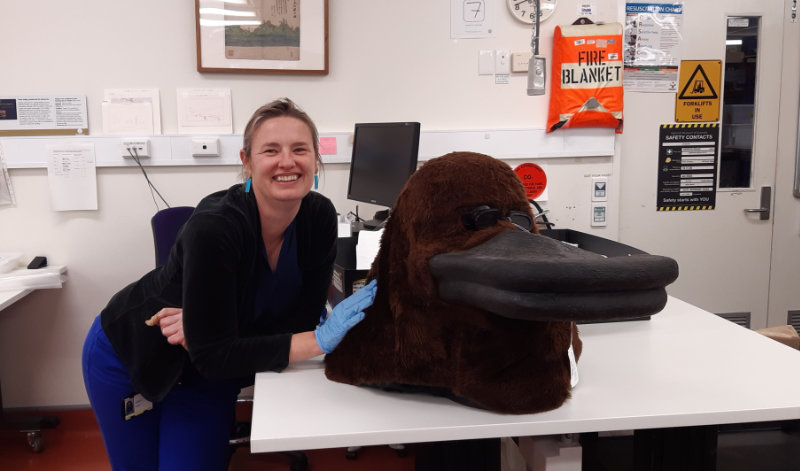
Danielle Hastie working with an item while at the National Museum of Australia (NMA).
We have recently welcomed Senior Conservator Freya Merrell for a seven-month secondment from the National Library of Australia for the period of May through to December 2021 as Exhibitions Conservator. Freya will assist with the upcoming in-house exhibition, Australians & Hollywood. Congratulations to James Campbell and Holly Murney who were the recent successful candidates for the two ongoing APS3 AV conservator positions. Kelly-Anne Bennett is currently acting as Exhibitions Registrar until the end of this year, and this has allowed for further movement within the team as we welcome Monica Connors to the AV conservators’ team.
Patrick O’Connor has spent the past few months as Acting Collection Reference Coordinator within the Access team and, while this occurred, Rose Cangadis-Douglass has been backfilling as Team Coordinator of AV Conservation. Pat has since returned to this role and Rose has returned to her substantive position as APS4 AV Conservator, to which she was recently made permanent.
Ash, Assistant AV Conservator, has been working recently on a number of items affected by mould, including a 16mm advert for Bushells tea! This film was short, but even something that is only a handful of seconds long can have significant importance in cultural heritage. Ash and the team have also been involved with preparing a range of works for the French film festival.
Events
NFSA was recently featured on Better Homes and Gardens for preserving all things film, tape, photos and vinyl—Mona Soleymani, Lewis Hinch and Rose could be seen in the new conservation lab chatting to BH&G host, James Tobin.
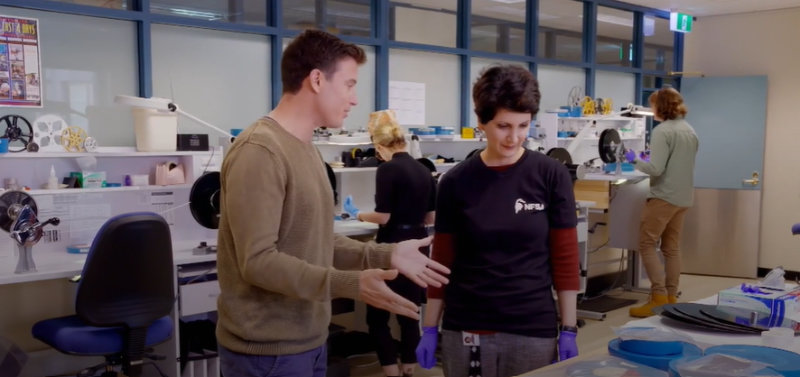
Mona Soleymani talking with James Tobin at the NFSA, as seen on Better Homes and Gardens.

Rose Cangadis-Douglass conserving AV material at the NFSA, as seen on Better Homes and Gardens.

AV material at the NFSA shown on Better Homes and Gardens.
Publications
Lisa Russ, PhD candidate from the Faculty of Arts & Design, Centre for Creative & Cultural Research at the University of Canberra, and Mona Soleymani, Manager, Collection Conservation, at the NFSA, collaboratively worked on mould on magnetic media, co-writing a peer-reviewed journal article. Mona was also busy with preparing some procedures – including ‘Managing Hazardous Chemicals in the Workplace’ – and updating the Mould Policy and IPM Plan.
Treatment projects
The conservation team has been busy treating and preparing films for both internal and external digitisation and screening requests. One notable request was Phillip Noyce Retrospective at the Cinematheque Francaise in Paris.
NFSA in Lockdown
The most recent Canberra COVID-19 lockdown has provided an opportunity for the team to update current policies and procedures, engage in professional development, and get on top on the tasks that we never get around to doing … that bottomless pit of admin! Mona has been very busy running a number of online internal trainings for all NFSA offices in Sydney, Melbourne and Canberra, including on Collection Format Hazards .
Exhibitions
The current exhibition on display at the NFSA gallery is Mervin Bishop, Australian Photojournalist, which opened in March this year.

Mervin Bishop exhibition at NFSA Acton Gallery.
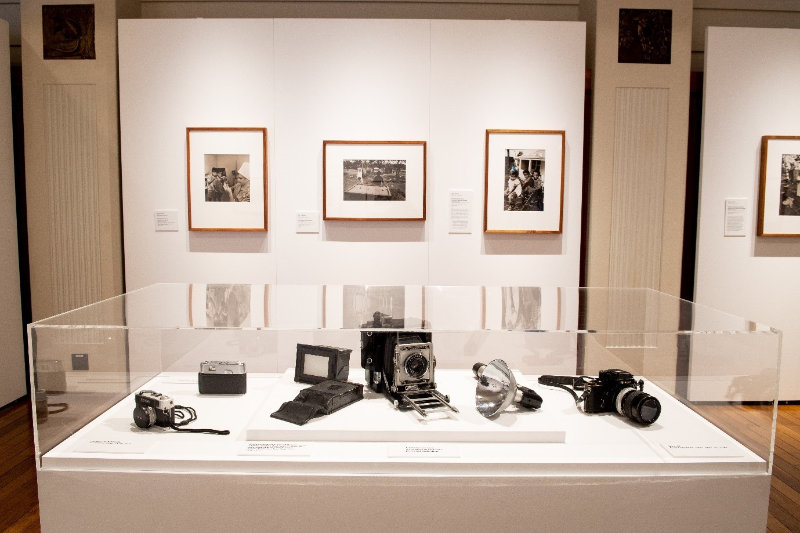
Mervin Bishop showcase display at NFSA Acton Gallery.
Kelly recently deinstalled The Dressmaker travelling exhibition, which is making its way through a number of regional galleries including Tamworth, Horsham, and Winton.

‘The Dressmaker’ exhibition at Tamworth Regional Gallery.
In some exciting news, the NFSA is currently working towards the upcoming Australians and Hollywood exhibition. This is the first internally developed exhibition of NFSA collection items in 20 years! Team leader for Conservation, Shingo Ishikawa, and Exhibitions Conservator Freya Merrell have been working with the interstate curator to finalise and assess proposed content for the display and begin preparations. Darren Weinert, Senior Imaging Specialist, has been working hard to not only keep up with regular digitisation requests but to digitise several works that are going on display and to create a 3D image for our Magic Mirror virtual display, which enables visitors to ‘try on’ costumes virtually in front of a screen.
A number of team members have been collaborating across the institution to establish an Exhibition Management System. This has meant regular communication with other institutions that are also using the same provider and seeking their feedback to tailor the system to the needs of the NFSA and build a foundation that allows for future internal exhibitions.
Conference attendance
A number of staff from the team attended the recent Australian Museums and Galleries Association (AMAGA) conference, and have participated in the recent online webinar Nanocellulose Films in Art Conservation with Remy Dreyfuss-Deseigne, an independent paper conservator based in Paris, and are eagerly awaiting the next session!
National Library of Australia
Staff changes
There have been quite a few changes to staff since March.
Our farewells (both temporary and long term):
Firstly, farewell and congratulations to Suellen Bailey, who has taken up the role of Assistant Director Digitisation Services at the National Archives of Australia.
Congratulations to Denyl Cloughley, who is now the Director of Design Integrity and Special Collections at the Department of Parliamentary Services for the next 12 months. A big thank you to Lisa Jeong-Ruess, who has been acting in Denyl’s role since Suellen left. We are soon to welcome another staff member to temporarily fill Denyl’s role for a longer period – keep your eye out for an announcement in the next AICCM Newsletter!
And, finally, a temporary farewell to Senior Conservator Freya Merrell, who has left us for six months to take on an exciting role at the National Film and Sound Archive as the Exhibitions Conservator. Congratulations Adele Barbara, who is acting as Senior Conservator, Exhibitions, in Freya’s absence, and Alex Genetzakis, who is filling Adele’s substantive role.
Camielle Fitzmaurice continues her secondment with the Grimwade Centre and we welcome Aurélie Martin, who is filling her role. Aurélie trained in Paris at the National Institute of Heritage, worked on the Ligatus Language of Binding Project, and is currently undertaking a PhD in bookbinding history.
We give a warm welcome to our other new staff:
Cheryl Jackson – Senior Conservator, Acquisitions, who brings over 30 years of conservation experience to the team and is a photographic materials conservator extraordinaire. She has already run a mini workshop for the team on black & white photographic materials.
Lucilla Ronai – Coordinator, Conservation for Digitisation, who comes to us from the Australian National Maritime Museum with a specialisation in paper conservation and an enthusiasm for sharing all things conservation.
Exhibitions and loans
Sara Freeman and Adele deinstalled the exhibition A Nation Imagined to make way for Illustrating the Antipodes: George French Angas. Sixty-seven items were speedily condition reported and prepared by the team, and multiple loans provided from national and state cultural institutions, as well as private collections. The opening of the exhibition is (currently) on hold but you can soon come to see the items on display. Preparation has started for the Circus exhibition with 30 items being worked on by the team. The centrepiece of the exhibition will be a six-part Bullen’s Circus poster, which, once fully assembled, will measure over 1.5 metres high by 3 metres wide!
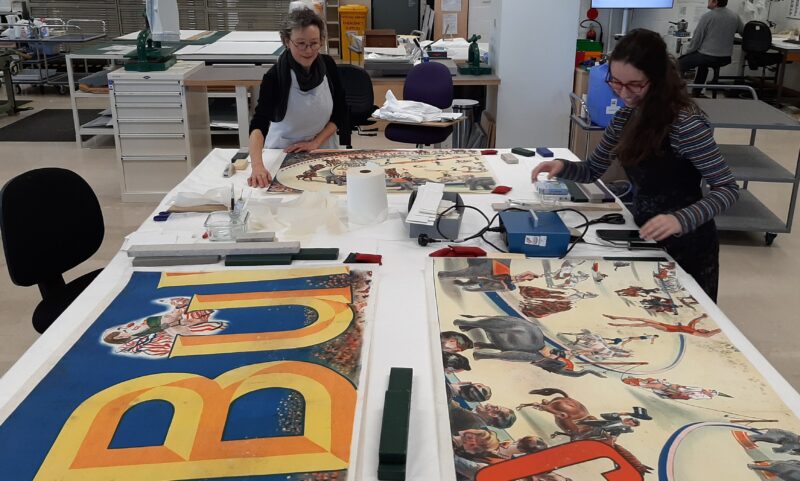
Sara and Adele Preparing 3 of the 6 parts of the Bullens Circus poster for display
Acquisitions
One hundred and twenty-six items from the March 4 Justice protest on Federation Mall have recently come into the NLA collection. The material is varied and includes placards, textiles and objects like a toilet seat! Cheryl has assessed their preservation needs and created custom supports to enable digitisation. Rehousing has commenced and they will soon be ready to find their new home in storage.
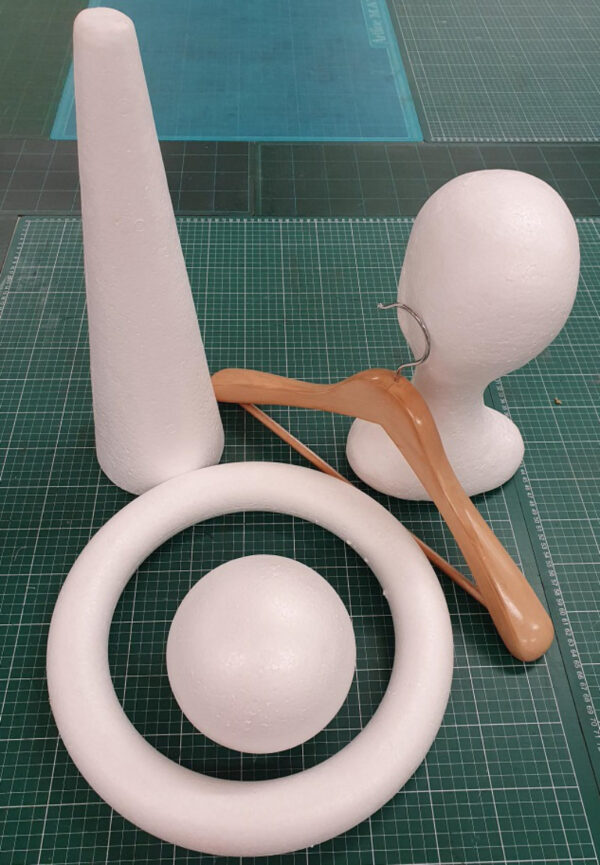
The start of some very creative supports constructed by Cheryl for the March 4 Justice new acquisitions in preparation for digitisation. Image courtesy of the National Library of Australia.
Digitisation
There have been many philanthropic campaigns, which are a driving force for a lot of the digitisation of the collection. It therefore generates a lot of preservation for digitisation to ensure the collection is prepared and stable.
Before treatment, we conduct surveys to assess the needs of the various collections considered for digitisation. Since April, 10 collections have been surveyed with more than 2000 items individually assessed.
Over 350 items have been treated since April in preparation for digitisation from the Sir Robert Menzies, Dame Nellie Melba and other collections. Jennifer Todd completed the treatment of 56 almanacs, which included extensive repairs to the volumes and stabilisation of fold-out maps.
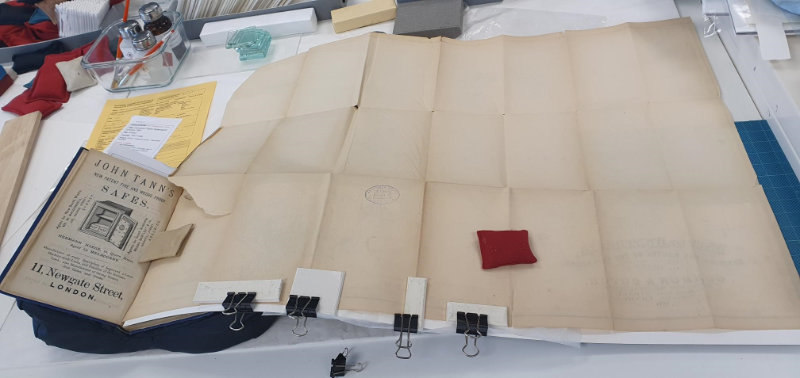
During treatment photo of an almanac fold-out map that Jen carefully unfolded and repaired. Image courtesy of the National Library of Australia.
Lucilla Ronai completed the treatments for incredible manuscript material related to Dame Nellie Melba, including silk programmes and letters, which can already be seen online here
Lucilla and conservation contractor Clair Murray continue to work on material from various collections, which should be online to enjoy soon!
Prioritised Treatment Program
On top of the busy exhibitions, loans, acquisitions and digitisation programs, the team works through treatments and collections selected through the NLA Prioritised Treatment Program. Overseen by Lisa Jeong-Ruess, the Collection Care team, since April, has treated 639 items across more than 22 collections.
Janet McDonald and Alex Genetzakis repaired and rehoused more than 450 fragile glass plate negatives and slides, part of MS 6429 Papers of Hubert Opperman. Some were extra small, only measuring 4cm x 2.5cm! Where needed, the glass plates where cleaned, and cracked and broken glass was replaced.

Image found by Janet during treatment of the Hubert Opperman (aka ‘Oppy’) collection showing very pre-COVID vibes (likely taken at a bike racing event). Image courtesy of the National Library of Australia.
Aurélie Martin treated a selection of 15 books from the recently acquired Jamie and Michael Kassler collection. The books date from the 19th century, with typical case bindings, and treatments included stabilisation and consolidating along the spine, joints and corners, and some even had to be completely resewn using original sewing recesses.

Aurélie sewing a Kassler volume after extensive repairs to spine folds. Image courtesy of the National Library of Australia.
Rehousing
Alex is our resident whiz box-maker, who planned and made a series of large-scale housings for a four-panel Chinese screen, which depicts scenes of battles and landscapes. This was in anticipation of the item being part of a collection move, as well as it being an ideal housing for long term storage.
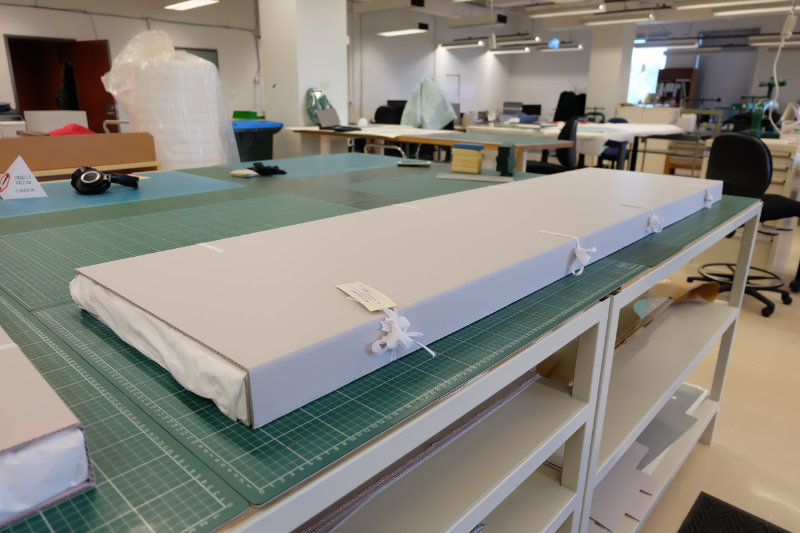
Custom box created by Alex for one part of a four-panel Chinese screen. Image courtesy of the National Library of Australia.
Another challenging item that required rehousing was the volume Murals of Tibet, weighing in at over 25kg! This was definitely a two-person lift!
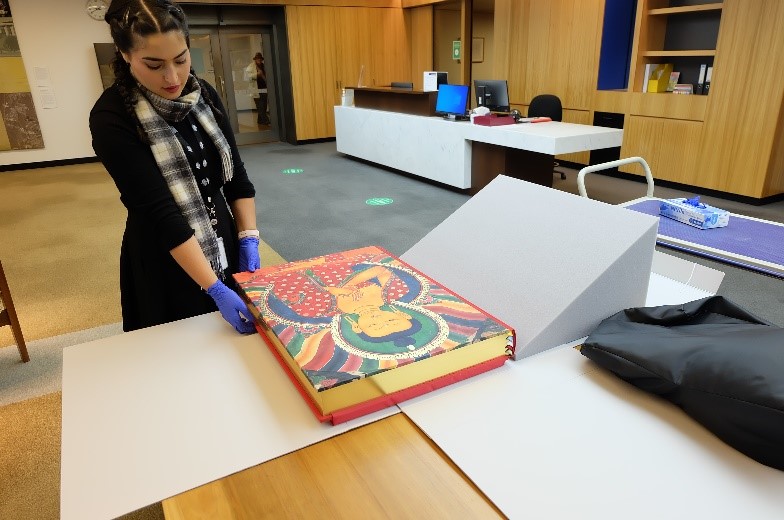
Alex showing Reading Room staff the newly constructed housing and support for the hefty volume
Outreach
Collection Care was visited by the Events team film crew to capture an ASMR (autonomous sensory meridian response) video. It was a first for us and the Events team. Some team members’ hands became famous. You can see the first one here

Excerpt from ASMR video on making wheat starch paste. Can you match a conservator to the hands? Image courtesy of the National Library of Australia.
We bet you’ve never focused so much on all the sounds we make while making wheat starch paste!
Amongst all this, Tania Riviere has reviewed and updated three major preservation policies – the Collection Care and Preservation Policy, the Illumination of Collection Items on Display and the Physical Collection Emergency Procedures. All these policies form part of the Collection Management Framework.
We are currently all in lockdown in the ACT and hope all our colleagues stay safe and well.

Collection Care team doing training while in lockdown
New South Wales
Art Gallery of New South Wales (AGNSW)
Exhibitions
The Conservation team is delighted to welcome our newly engaged Exhibitions & Loans Conservators, Lisa Mansfield & Madeleine Ewing, who have further expanded the specialised skills within the team, enabling us to cover a broader range of treatments and tasks and free up lab hours. Frances Cumming and the team are currently focusing on assisting with the changeover of the Old Courts, the deinstall of the National, as well as preparing for the deinstall and extended tours for both the Archibald Prize 2021 and the Archie 100. Additionally, we are in the thick of planning for a diverse suite of exhibitions that are running in concert with the summer exhibition, Matisse: Life & Spirit.
Time-based Art (TBA)
The Time-based Art conservation department has been using lockdown to focus on a range of collection maintenance tasks, review internal workflows and procedures with cross-departmental colleagues, and further develop and progress a number of significant collection care projects; notably including an Obsolete Technology Survey of the TBA Collection and a dedicated Software Preservation Project focused on developing best-practice standards for the acquisition and ongoing care of software-based artworks in the Gallery’s collection.
While working from home, the TBA Conservation team has been focusing on acquisitions, commissions and exhibitions associated with both the existing Gallery building and the Sydney Modern Project, as well as reviewing ongoing access, storage, and digital preservation requirements for the TBA Collection.
Rebecca Barnott-Clement, Jonathan Dennis and Lisa Mansfield were recently joined by a student from the University of Sydney Master of Interactive Design course, Mei Wilkinson, who is currently undertaking a research internship with the TBA Conservation department in conjunction with the Software Preservation Project. She is warmly welcomed to the team along with our numerous colleagues from other conservation specialisations who have volunteered to assist the TBA Conservation department with research tasks during the lockdown period.
Paper
The Paper team is delighted to announce the appointment of Lois Waters (she/her) to the team in a permanent role. Lois commenced working at the Gallery on a contract in late 2019 and has made a significant contribution to the team over that time. The team also welcomes Bernadette Jones (she/her) who has commenced working 1.5 days per week as a technical assistant. Bernadette comes to us with a wealth of hands-on experience and we are delighted to have her on board.
Over the course of the last two months the team has been adapting to this latest lockdown, which has involved several new challenges. Sarah Bunn (she/her) has been working on the Dobell Australian Drawing Biennial: Real Worlds tour, which concluded at the Museum of Art and Culture at Lake Macquarie in mid-July. Due to COVID-19 restrictions, Gallery staff couldn’t travel to condition check and deinstall the exhibition, so we revised the tour manual, held several online meetings with both institutions to plan the deinstall process for the more complex, unframed works on paper, and were on call for the deinstall if required – we weren’t!
Equally, Analiese Treacy (she/her) has been working virtually with the team at Bendigo Art Gallery and Peter Michelson (Conservator from the University of Melbourne – acting as a wonderful stand in), to oversee (via Facetime) the installation of the Brett Whiteley Drawing is Everything touring exhibition. In this instance the AGNSW team could not travel to install the show due to closed state borders, but the combined efforts of all involved resulted in the show opening successfully as planned.
The Paper team has also been attending early planning meetings for our impending Sydney Modern Building, due to open in late 2022. It has been exciting to be part of the planning for such wonderfully innovative and creative exhibition spaces. The team has also been taking this opportunity to avail of online training courses, with Lois Waters and Sarah Bunn each attending one of the nanocellulose courses offered by Remy Dreyfuss-Deseigne, and Analiese and Sarah participating in the upcoming ICON BPG21 conference taking place in October via a talk, poster and a behind-the-scenes tour of the AGNSW paper lab. This period of closure has offered a rare opportunity to write up interesting projects, catch up on the ever-important task of data entry, and take on a backlog of other administrative tasks.
Mount cutting
The mount cutting team, not being able to continue with its work onsite due to lockdown, has been busy with doing digital gardening across the conservation department and beyond, with some cross-pollination activities at its heart. Julia Bavyka (they/them), who joined the team in February as a technical assistant in mount cutting, has been sharing this job with Jonathan Dennis (he/him) since then. In the past weeks Julia has been working across teams to ensure the completion of a tools, materials and equipment list required for our new conservation lab space, currently in construction as part of the Sydney Modern project. Our wonderful Diversity & Inclusion Manager, Sherryl Reddy, organised a LGBTQIA+ Awareness Session with Nicki Elkin from Pride in Diversity in late-July, which was highly attended by Gallery staff. Julia was one of the facilitators of a Q&A session afterwards and will continue their voluntary work in establishing a LGBTQIA+ and Allies network at the Gallery. They are currently working in multiple groups, supporting research activities in time-based art, and drafting a text about mounting of recently acquired works by Ana Maria Pacheco (Brazil, b.1943).
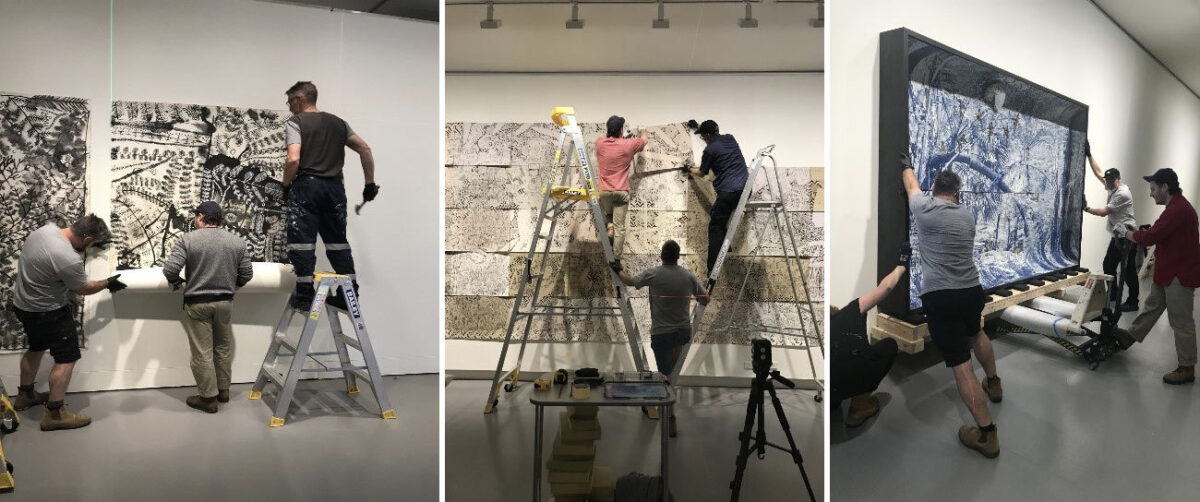
Art Gallery of NSW and Museum of Art and Culture staff installing some of the more complex works on paper included in the Dobell Australian Drawing Biennial: Real Worlds at Lake Macquarie, May 2021.
Objects
The Objects section welcomes a new staff member, Bronwyn Tulloh. Bronwyn brings a wealth of experience from her previous roles, so the entire team is absolutely thrilled to have her on board. Sofia Lo Bianco has been consulting on several interesting commissions, which the Gallery will reveal along with the opening of our Sydney Modern Project. These commissions require in-depth research and planning – yet provide a wonderful platform for creative and collaborative thinking. Kerry Head has been diligently working on the preparation of a number of works for both the Grand Courts re-hang due to open in November and the Matisse Alive exhibition, also due around the same time. The objects team has also moved studio and is finally part of the larger team. Having the team together now allows us to work more particularly as art becomes increasingly cross-disciplinary.
Paintings
The Paintings section has mainly been working on the Gallery’s Old Courts project for the past few months. Paula Dredge, Andrea Nottage, Madeleine Ewing, and Simon Ives have respectively been undertaking major conservation treatments on portraits by Joseph Backler, a Hilda Rix Nicholas’ new acquisition, Hermione, by Thomas Francis Dicksee, and The lady in blue by Hugh Ramsay, while Celine de Courlon, Melissa Harvey, and Sophie P d’Abrigeon have been focusing on minor treatments, structural work on the backs of frames, and hanging systems. Unfortunately, all treatments had to be put on hold in early July due to the lockdown. Since then, the team has been collaborating with the rest of the Conservation department on training materials, administrative work and the planning of future exhibitions and projects.
Congratulations to Madeleine Ewing who just joined the Exhibitions conservation team! Madeleine has been working on the Old Courts project as well as the outward loans program within the Paintings team since March. She has been a very valuable and appreciated member of our team; we wish her all the best in her new role and we look forward to working with her on future exhibitions.
Frames
The Frames conservation team is happy to have recently returned to onsite work at the Gallery as of Monday 16 August. Geneveive Tobin and Basia Dabrowa have been continuing minor treatments to stabilise, clean and retouch gilded frames for the Grand Courts rehang, working closely with Paintings and tech teams to regularly revise and reprioritise what is achievable, in addition to assessing and completing what is possible for the loans program.
Unfortunately, we have had to temporarily halt our benefactor supported projects until next year due to current circumstances. Margaret Sawicki has been working on the major treatment of the classical frame for Thomas Francis Dicksee’s Hermione (c. 1874) and we are hopeful this major treatment may be continued next year along with the major treatment of the frame for Gordon Coutts (aptly named) Waiting (c. 1895), also included in the rehang.
We have also had to temporarily suspend completion of the two identical 19th-century frames for portraits by Joseph Backler, the results of many months of practical research. Basia worked to treat these frames, which require more time to finalise, while the third Backler portrait required a reproduction frame identical to the others complete with its own fabrication challenges. The reproduction frame was achieved through close collaboration with the Frames team and executed with fantastic results by Tom Langlands. It is remarkable how well the frame complements and spotlights the details in the recently restored portrait of Elizabeth Collins (c. 1861). Tom has been very hard at work making 40 standard frames for watercolours included in the rehang in addition to reproduction frames for paintings. He is currently finishing a frame for a marble relief by William MacIntosh and working on a repro frame for an Emily Carr painting.
Joseph Backler
Portrait of Elizabeth Collins 1861
oil on canvas, 77.9 x 63.8 cm, 89 x 77 x 7 cm frame
Art Gallery of New South Wales
Gift of Mrs J C Williams and Mr O C Tunks 1990
Photo: Genevieve Tobin, AGNSW
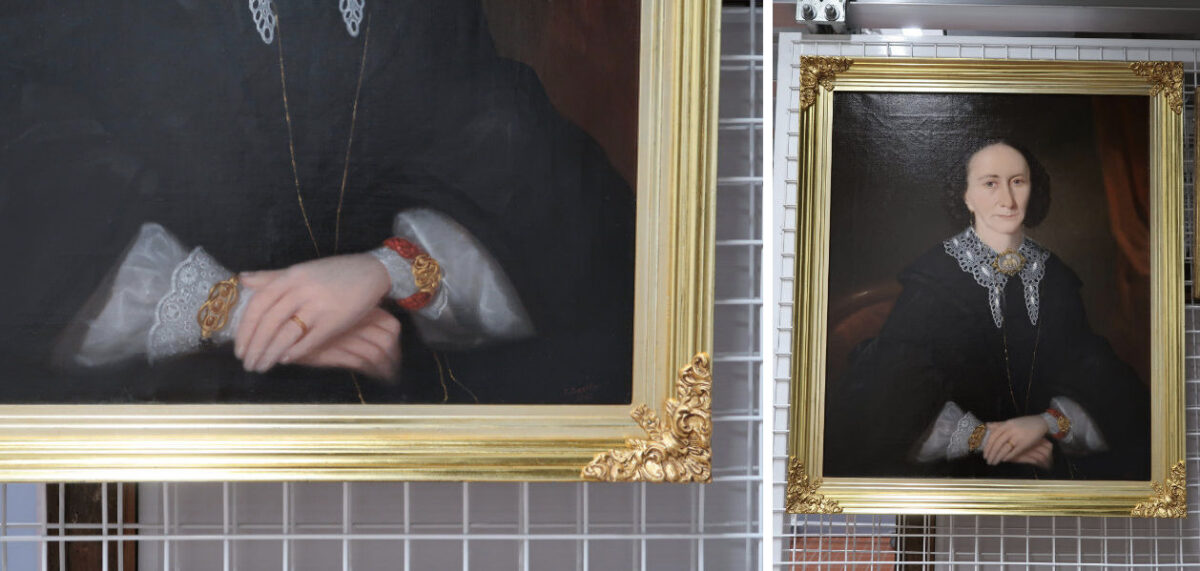
Left: Detail of reproduction frame, highlighting complementing gold ornament detail in both frame and painting.
Right: Reproduction frame for Joseph Backler Portrait of a Woman (Elizabeth Collins) c. 1861
Australian Museum
Collection Care and Conservation
Staff update
It’s official! Heather Bleechmore has been appointed to the role of Manager of Collection Care and Conservation at the Australian Museum. Whilst acting in the role over the past year, Heather has had more than a few operational challenges to contend with, such as bringing the new Conservation lab to fruition and navigating the team through the COVID-19 pandemic. This appointment is welcome news indeed.
Lab update
The Collection Care and Conservation team had only just settled into their new lab when COVID-19 reared its ugly head again and most of the team found themselves working from home for the foreseeable future. An aspect of the new lab is the ‘on view’ windows into the Education corridor, which meant that the team was getting used to seeing students, staff and the public looking in over the lab. To those who had not visited the AM Conservation lab prior to the refurbishment, it was a bit of a bunker with no windows. Now we have views to the outside world and are welcoming the new sense of connection. In May the lab became fully operational and in July the IPM room housing the nitrogen chamber and walk-in freezer was brought online.
Professional news
Rehan Scharenguivel recently presented at the ‘AICCM Agents of Change Series: Pests’ on a heat treatment completed recently. The talk covered the use of moist heat chambers to successfully pest-treat cultural materials and the considerations involved when undertaking the treatment. Being from Sydney, hot humid air is something that we are all used to, so utilising a controlled humidity heat treatment is a pathway the Museum will definitely be using again.
Also, Rehan will be presenting a paper with Jessica Gray (Preventive Conservator, MAAS) at the upcoming ‘Pest Odyssey: The Next Generation’ conference. The paper will cover regional-specific digital collaboration in tackling pest issues. If you’re not yet tired of Rehan’s voice, you can find more details on the conference here
Treatment project
Michael Kelly is currently carrying out a treatment project on a collection of early correspondence (1880s) from the Archives collections. The treatments include cleaning, stabilisation, and re-housing.
Rehousing Types Project
The Palaeontology Rehousing Project finished at the end of June with over 3,000 fossil specimens rehoused. Sophie Phillips, under the guidance of Sheldon Teare, has been developing and implementing updated housing systems for the collection using new archival-grade boxes and supports, offering greater protection to specimens while housed in drawers, as well as during handling. The methods developed in this project will be used to continue re-housing the remaining Type collection specimens over the coming months.
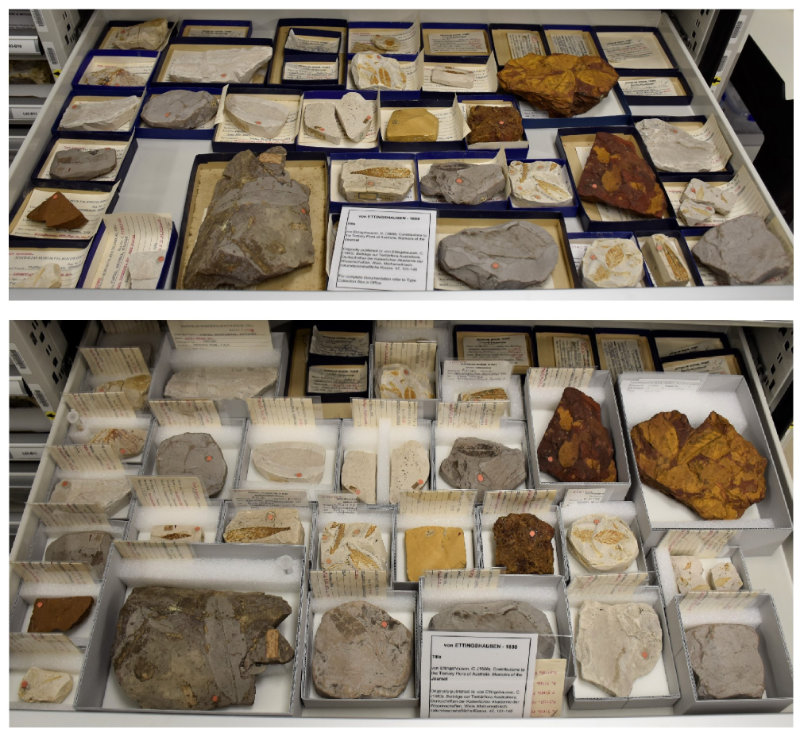
Fossil type specimens in upgraded archival housing, before and after.
Collection Enhancement Project
Whilst continuing to investigate white substances forming on Entomology collections, Clare Kim has been exploring possible methods to minimise the appearance of these substances from the affected specimens. Solubility tests have been conducted using carefully selected solvents, followed by treatment undertaken under a microscope on specimens from the teaching collections. The experiment at this stage aims to develop treatment methods to lessen the visual impact of the substance for when specimens may be required for taxonomy research or exhibition purposes.
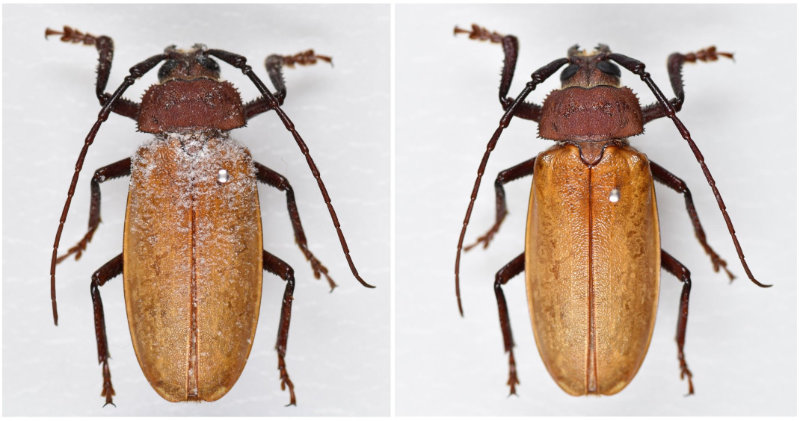
Specimen with possible fatty acid, before and after treatment.
Exhibitions
Kyra Kim will be undertaking a repair of the wooden shields from the Unsettled exhibition. Due to the restrictions imposed by the COVID-19 lockdown, this repair will be led by the First Nations artists via a virtual conference. This is an exciting opportunity to initiate community-led treatments and virtual consultations.
Megan Dean-Jones has begun but has had to put on hold the condition assessment and processing of the approximately 1600 spectacular mineral specimens selected for the new permanent Minerals Gallery. Work on this gallery, which is due to open in late 2022, will continue once the team can resume working on site.
Collection Care
The IPM program has been kept busy during lockdown with regular gallery and trap inspections still taking place. This has helped the team stay on top of any outbreaks that may be occurring while everyone is away from the Museum. This has certainly meant that the usual slowdown of the IPM program over the cooler months has failed to occur this year but if the bugs aren’t hibernating, then we can’t either.
Australian National Maritime Museum (ANMM)
Staff changes
We welcomed Amy Walsh to the conservation team in mid-June. Amy joins us from International Conservation Services and has a background in objects conservation, specialising in ceramics and archaeological materials. She brings a diverse treatment skill set and project management experience, all of which she is excited to apply in an institutional setting.
Sadly the Sydney lockdown has meant that our interns or volunteers have been unable to visit the lab since late-June. We look forward to welcoming everyone back when it is safe to do so.
Treatment projects
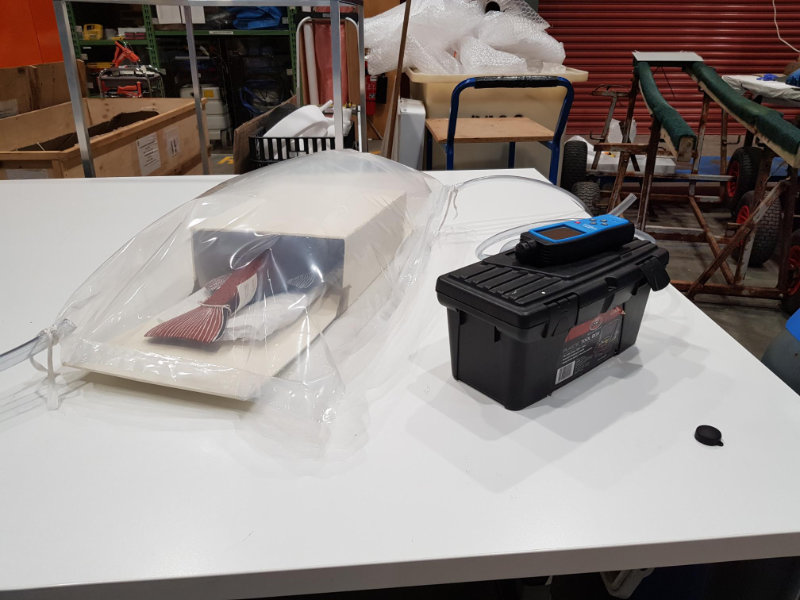
A fish from Guykuda’s Aquarium undergoing anoxic treatment. Image by J Fox.
During June, Jeff Fox and Amy worked with Alex Roach from Modified Atmospheres to undertake anoxic pest treatments on a contemporary artwork entitled Guykuda’s Aquarium, which consists of 17 wooden sculptures of various fish species by Yolngu artist Guykuda Mununggurr. In order to reduce our environmental impact, supports for the delicate sculptures were fashioned out of recycled cardboard and the barrier film will be reused for future pest treatments.
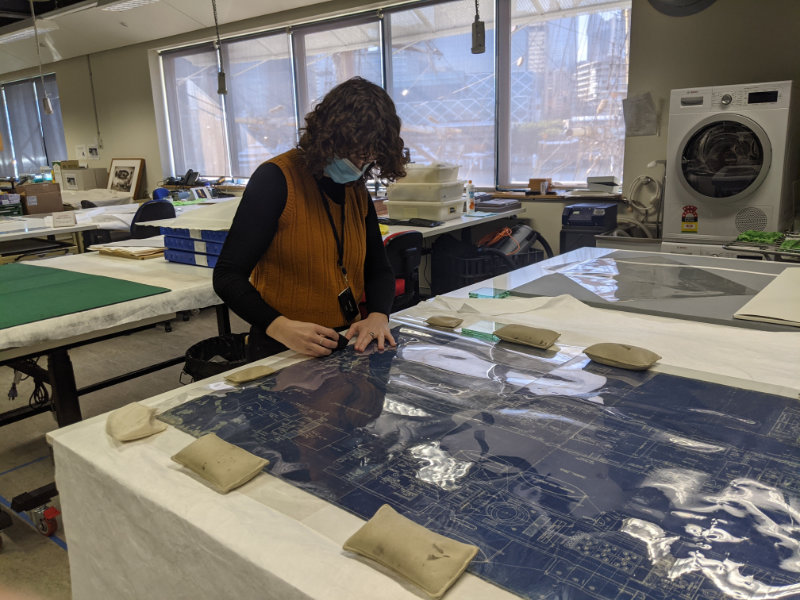
Paper treatment in progress. Image by E Hayles.
In the quieter weeks before full lockdown, Emma Hayles and Amy undertook a number of treatments on paper-based objects, including prints, blueprints and maps. Works included removing acidic supports, humidification and flattening, tear repairs and remounting into new conservation-grade window mounts. The quiet nature of the lab meant it was possible to work on these large objects – many greater than A2 in size – without concerns for taking up too much space.
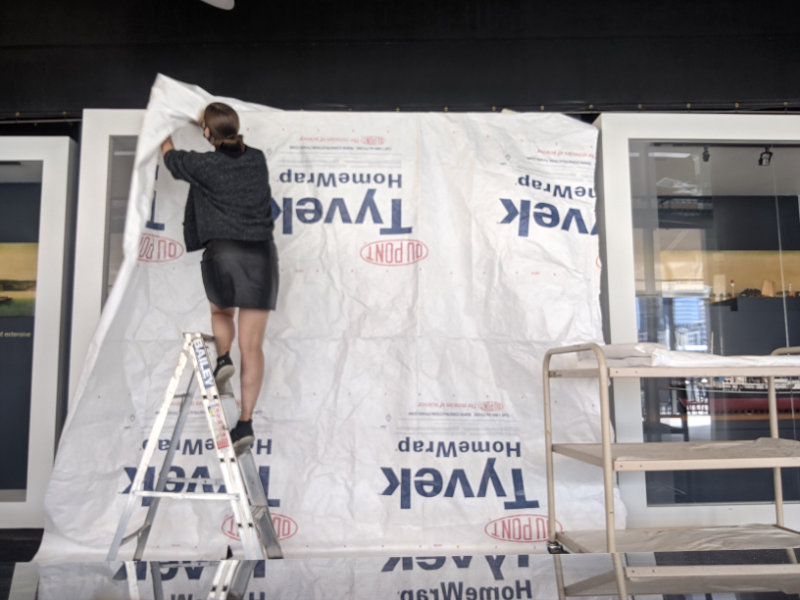
Putting the Museum to sleep. Image by A Alvis.
Like at other museums and cultural institutions during lockdowns, Alayne Alvis, Nick Flood, Emma and Amy were able to take advantage of the shutdown to undertake valuable maintenance cleaning on a number of open display objects, many of which are difficult to access. Armed with vacuums, brushes, microfibre cloths, masks (for the dual purposes of COVID and dust prevention!) and a scissor lift, the team cleaned several large vessels and sculptures dotted around the main Museum building and the Wharf 7 foyer. This period also gave us the chance to put the Museum ‘to sleep’. Lighting was turned off, outward-facing showcases were covered, displayed books were closed and garments were taken off display to rest.
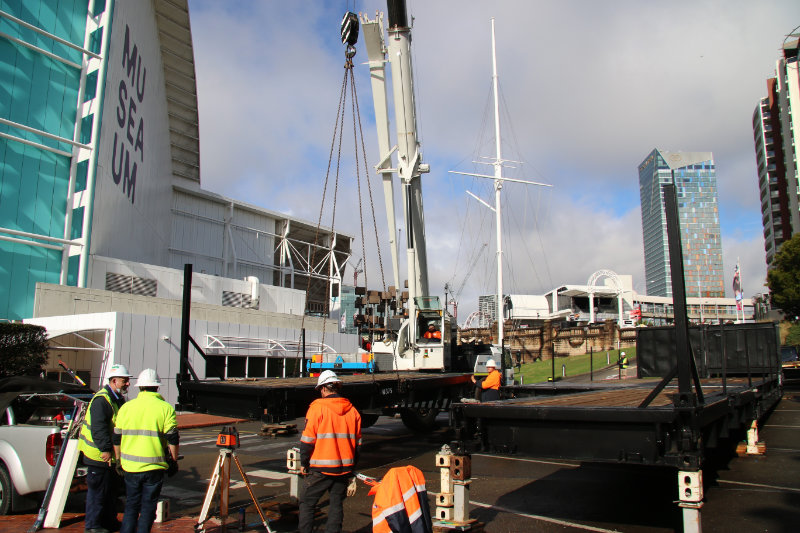
Assembly of Tu Do’s platform by crane. Image by E Hayles.
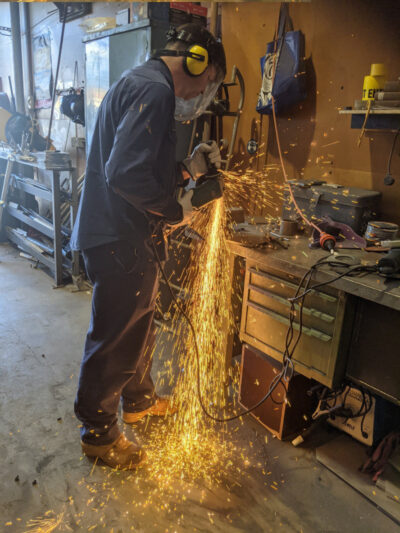
Nick fabricating stanchions. Image by E Hayles.
With Conservation Manager Agata Rostek-Robak at the helm, the whole team has been hard at work in preparation for the major treatment of Tu Do, a Vietnamese refugee vessel. The 18.25-metre boat will be lifted from the harbour, cleaned and slowly dried under controlled conditions, allowing it to eventually be displayed inside the Museum. The first stage of the project was undertaken in late-June, with the crane installation of a large platform structure in the Museum’s bus park – this is where the treatment will take place over the course of several years. Additionally, Emma and Nick had the opportunity to hone their welding skills in order to fabricate stanchions, which will surround the deck of the vessel for safety purposes. Tu Do was scheduled to be lifted from the harbour in mid-August – while the Sydney lockdown has meant that this exciting moment has been postponed, there is still plenty of preparation work underway to ensure the whole project runs smoothly.
Research projects
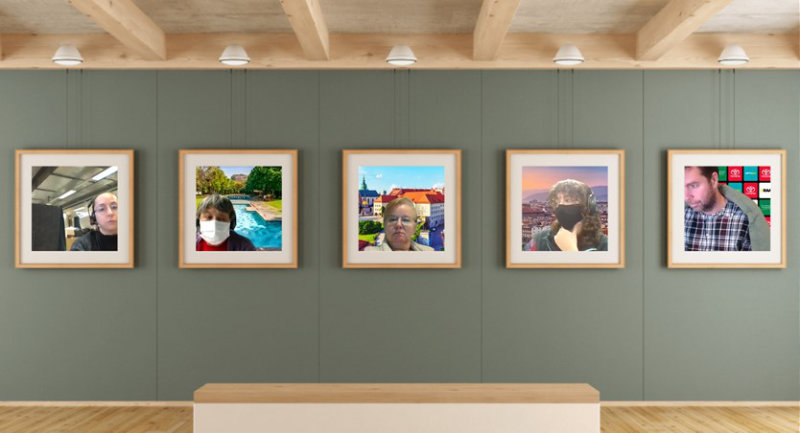
Masterpieces! – making the most of Zoom filters. Image by E Hayles.
Due to lockdown, the conservation team has been working from home for much of July and August. This has provided the perfect opportunity to catch up on administrative tasks and undertake research that will help to develop the Museum’s Hazards in Collections Management Plan, update IPM systems, improve PPE usage and fine-tune safety protocols for collections and staff. The team has been keeping in touch (and entertained) via Zoom, with regular cameos from beloved pets!
Exhibitions

Emma preparing for treatment of the Sentinels. Image by E Hayles.
Alayne, Amy and Emma have mostly completed treatment of objects for the upcoming One Ocean Our Future exhibition. The final objects, Gumbaynggirr artist YOMA’s Sentinels has arrived on loan. These large-scale figures, some reaching 280 cm tall, are 3D printed and were previously displayed in Circular Quay for Vivid. Having weathered the elements, they required a thorough clean before they can take pride of place within the exhibition.
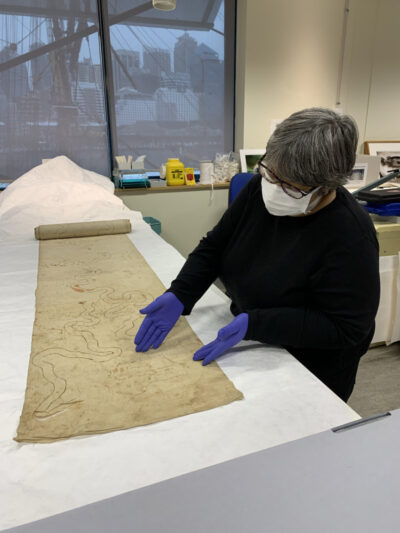
Alayne inspecting one of the river maps, highlighting an inscription. Image by A Walsh.
Alayne has also had the chance to work on three beautiful river maps, which have been drawn on long rolled textiles. These interesting pieces are being assessed and documented for an upcoming exhibition scheduled for 2022.
Amy had the pleasure of receiving and condition checking a collection of maritime archaeological objects from the wreck of the Japanese pearling boat Sanyo Maru. This collection, which is on loan from the Northern Territory Government, included ceramics, lacquerware, chopsticks and even a small surgical kit. The objects will be digitised by ANMM and exhibited in the near future.
Conferences
Despite the lockdown keeping everyone stuck in Sydney, Nick ‘travelled’ all the way to Lucknow, India, to virtually attend the Archaeometallurgy and Scientific Analysis of Ancient Metal Objects course run through the National Research Laboratory for Conservation of Cultural Property.
Jeff and Emma also attended a forum on Pests, as part of the 10 Agents Over 10 Months series presented by the AICCM Preventive Conservation Special Interest Group. They enjoyed hearing from Australian and international colleagues, keeping up to date with what’s happening in the field of IPM.
International Conservation Services (ICS)
ICS Melbourne
Over the last few months, ICS Melbourne carried out maintenance and repairs on Ola Cohn’s Fairies Tree at Fitzroy Gardens. The team also applied preventive measures to preserve the Aboriginal Scarred Tree for the City of Melbourne.

Kristine Allinson works on the Fairies Tree. Image by International Conservation Services.
Objects conservators Bruno Bell and Kristine Allinson continued their work on two archaeological assemblages excavated on King Street. The team has been trialling the use of electrolysis to reduce corrosion product on silver coins with good results.
Eden Christian, of ICS Sydney, joined Katie Smith in Melbourne to treat a collection of paintings and frames from Beleura House and Gardens in Mornington.
Two members of the ICS Melbourne team were recognised with promotions in July. Bruno Bell was promoted to Senior Objects Conservator and Kristine Allinson moved into the role of Conservation Projects Manager.
Paintings
In Sydney, the Paintings Team has been working on the National Trust’s largest conservation project ever, the ‘Rescue Revive Reveal’ Program. Our team really enjoyed meeting with the Trust’s donors (pre lockdown), and helping to raise awareness about the process and value of conserving the collection. Work includes extensive conservation of the collection, plus research and authentication.
Claire Heasman and Matteo Volonté have been involved with the paint investigation and identification of original paint colours for the internal finishes at Rose Seidler House in Wahroonga.
The whole Paintings Team has been treating four large paintings from the collection of St John’s College over the last few months. A beautiful transformation occurred after consolidation and varnish removal.

Virgin and Child, After Murillo, before and after treatment. Image by International Conservation Services.
Paper
The Paper Team is breathing a sigh of relief having just finished a large mould remediation project. In addition, Katie Wood has been working on consolidation and tear repairs for four antique Japanese paper panels for a private client. Caroline Whitley disassembled, cleaned and repaired the components of three ambrotypes for the National Trust. Caroline and Katie recently undertook an assessment of Captain Cook’s Tapa cloth sample book for Te Papa, Wellington, NZ.
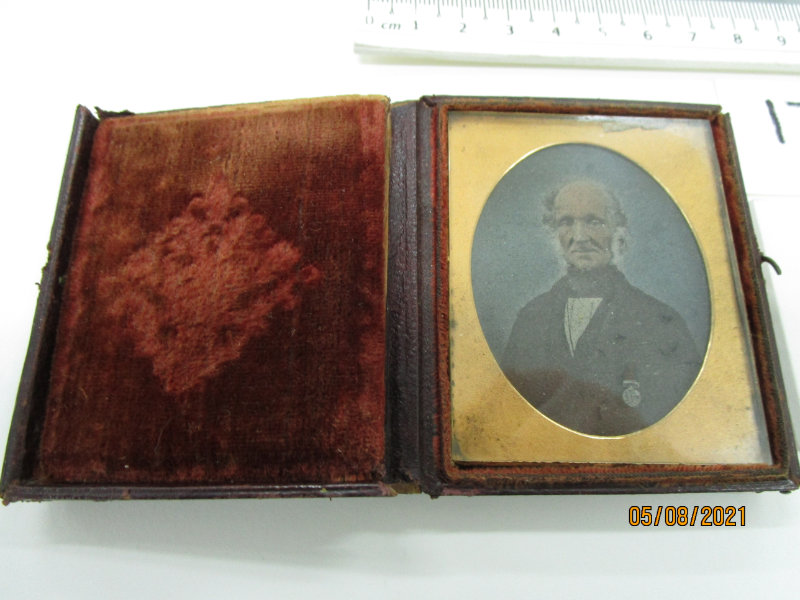
Ambrotype during treatment. Image by International Conservation Services.
Objects and Outdoor Heritage
The Objects and Outdoor Heritage Team has been delighted to welcome Alis Jitarescu into the role of Objects Conservator in July. Alis has a wealth of experience with a wide variety of materials and techniques, both on site and in the lab, including religious items, icons, oil paintings, furniture, frames, sculpture, murals and interiors.
Wendy Reade has been working diligently on an anchor from a French navy ship that explored our coastline in 1788. This 230-year-old relic, from the last voyage of navigator Jean-François de Galaup, Comte de La Pérouse, is being returned to public display at the La Perouse Museum after the conservation work is complete. The conservation project has been several years in the planning.

Keir Bayley brings the La Perouse Anchor into the ICS loading dock. Image by International Conservation Services.
The Team recently undertook assessment and treatment of the Bruce Lee sculpture in Kogarah Square. The bronze sculpture was exhibiting pitting as a result of the casting process. The corrosion was removed, and the surface protected by microcrystalline wax coating.
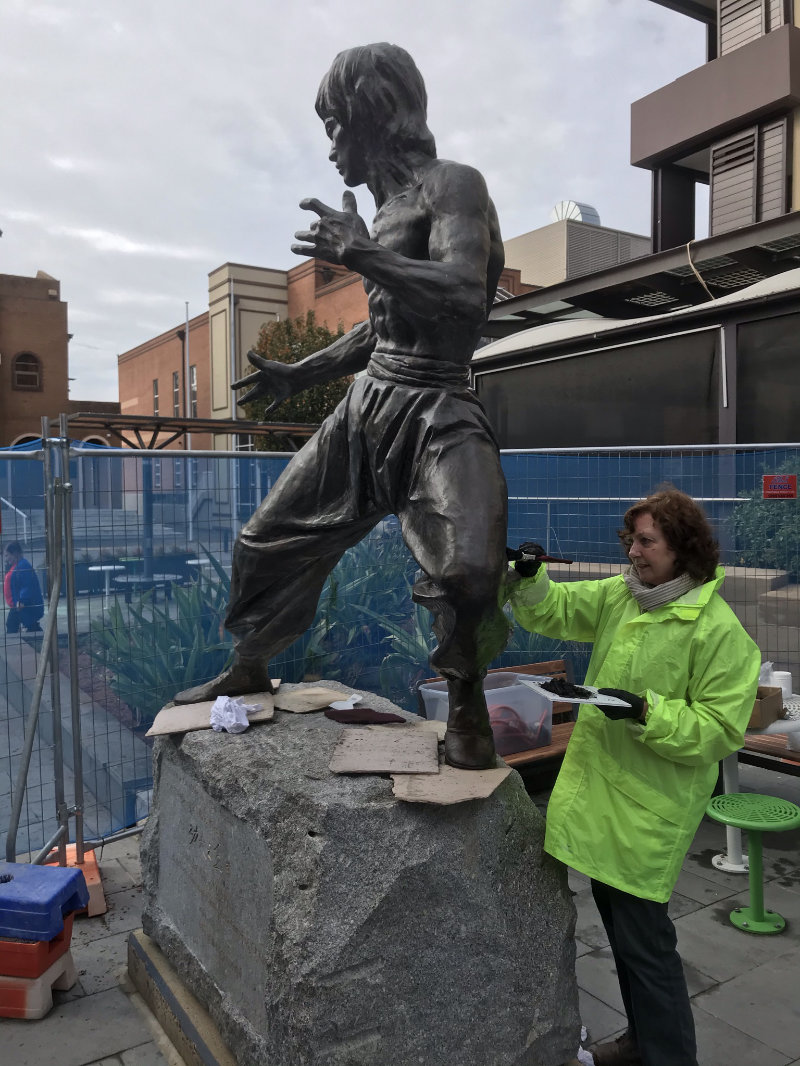
Wendy Reade applies a wax coating to the Bruce Lee sculpture. Image by International Conservation Services.
Claire Rowson and Keir Bayley also worked on the conservation of the shield elements at Wireless House in Glebe. The Team also completed conservation works on a Venetian glass mirror, including cleaning, reattaching elements, and installation on site.
Textiles
In the Textiles Department, Principal Textile Conservator Christina Ritschel has completed stabilising and mounting a small collection of maritime flags and burgees. With the assistance of Conservator Alis Jitarescu, a 1930s leopard skin floor cover has been cleaned, relaxed and pieced back together, and has received a new felt backing. Alis also stabilised and built an improved support for a Native American headdress.
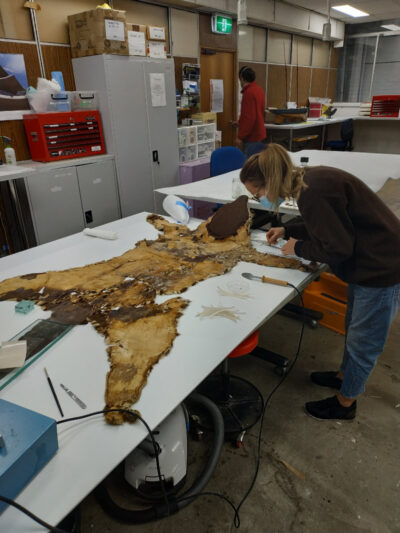
Alis Jitarescu stabilising the leopard skin floor cover. Image by International Conservation Services.
Alis and Conservation Assistant Yolanda El Khouri carried out surface cleaning, crease reduction and mounting of a WWI flag with embroidered inscriptions. They also conserved a large 18th–19th century tapestry, which required removal of the previous backing, stabilisation of weak areas, application of backing straps to evenly spread the weight while hanging, and then application of a full backing and Velcro hanging system. Yolanda also mounted a Chinese embroidery in preparation for framing, and carried out surface cleaning of a Japanese kimono in preparation for storage.
Furniture
The Furniture Team has been completing extensive work on a fine collection of mid-18th century English furniture, including a delicate rosewood desk with tambour top. Oliver Hull also worked on a sculpture for White Rabbit Gallery of a leather jacket hanging on a chair, skilfully carved out of wood by artist Yang Pei-Chen.

Work in progress on Leather Coat, Yang Pei-Chen. The leather jacket is carved out of wood. Image by International Conservation Services.
Shane Orion Wiechnik completed work on a number of small objects including replicating lost fine marquetry on a small Sorrento music table, as well as beginning tests and surface work on a six-panel decorative East-Asian lacquer screen. Luke Mitchell has been guided through the process of marquetry and surface conservation on a large Boulle glass door cabinet.
Museum of Applied Arts and Sciences (MAAS)
Staff changes
Meredith Freeman PhD is the new Conservation Manager at MAAS and started in the role in June 2021. Meredith has a strong background in project management and policy development within government, private and not-for-profit organisations. On completing her Master of Arts (Cultural Material Conservation) at the University of Melbourne, Meredith was awarded the inaugural Headley Trust / Crick Smith scholarship at the University of Lincoln, UK. Her doctoral research explores the science and agency of decorative schemes associated with built heritage and their contribution to the interpretation of the social and historical context of interiors. She has worked extensively as a conservator and conservation manager in private practice in the UK and more recently as Senior Conservation Projects Manager at ICS, Australia.
A big thanks to Kate Chidlow for steering the Conservation Unit over the past year.
Jessie Gray has been appointed as Preventive Conservator. Jessie will continue developing policy and procedure for integrated pest management and environmental monitoring and implement the Museum’s Preventive Conservation Program.
Elizabeth Reed has been appointed to work on the packing phase of the Collection Relocation and Digitisation (CRD) Project.
We farewell Gosia Dudek, Senior Objects Conservator, who has retired from MAAS after a career spanning 35 years. Both longer-serving and newer staff consider themselves fortunate to have worked alongside Gosia. She is a remarkable conservator, and her skill in objects conservation is unparalleled. Having trained in Poland, her education was intense and thorough, encompassing not only techniques relevant to the treatment of objects but artistic pursuits such as life drawing, sculpture, technical drawing, painting and model making. Gosia is a perfectionist; everything she has worked on is always completed to the highest calibre. Over the years we have learned so much from her; she will be missed both as a colleague and as a friend. We wish her all the very best for the next chapter.
We bid a fond farewell earlier this year to Carey Ward. After more than 40 years of service working with MAAS, Carey and his wife Anne have moved to Bathurst for their next adventure. Carey will be missed, not only for his significant skills and knowledge but more importantly for his friendship and sense of humour.
We farewell Margot Murray who is taking up the Sherman Fairchild Foundation Conservation Fellowship in Objects Conservation with The Metropolitan Museum of Art, New York. Margot brought a wealth of experience and skill in the treatment of ceramics from training and experience in Australia and the UK and quickly became a valued member of staff. We wish her well in this next adventure.
The CRD Project continues with assessment in the Special Collections team, welcoming Assistant Conservators Amy Heffernan, Bindiya Kumar, Caitlin Knight and Emilia Zambri. Freya Gabbutt resumes the role of Conservation Deputy Team Leader and Anurati Krishnamurthy will act in the position of Conservation Team Leader for Special Collections.
Events
In August, as part of the Powerhouse Museum’s 2021 Regional Public Program, Brooke Randall and Jessica Gray presented a webinar discussing preventive conservation and the identification of hazardous materials in museum collections. The webinar had 99 participants joining from small museums in regional and western Sydney to larger institutions from NSW and interstate.
Project and treatment update
The restoration of Sydney Observatory’s Messenger’s Cottage built in the 1890s is now complete and will be a centre for visiting fellows participating in the MAAS Residency Program. Residents have been selected from across a diverse field of practices including astrophysics, science, philosophy and the environment, to visual art and theatre.
Dave Rockell has been updating our records for the very large objects in our collection including our locomotives and aircraft. At the Museum Discovery Centre at Castle Hill, Dave is reviewing and implementing improved storage solutions for the cars in the collection.
The General Assessment Team of the CRD Project celebrated the end of the assessment phase on 30 June 2021.Our Paper, Books & Photographs conservators have now completed a combined total of 1,245 conservation treatments for the CRD Project. This work has largely been undertaken by paper conservators Beate Yule and Karina Lavings but has been a team effort with treatments also undertaken by conservator Bronwyn Dunn and the previous CRD paper conservator, Rebecca Main. Beate and Karina are currently working from home and have a minimum of 567 treatments to complete when restrictions ease and they’re able to return to the Museum.
Conservation research
Jessica Gray (Preventive Conservator, Museum of Applied Arts and Sciences) and Rehan Scharenguivel (Collection Care Conservator, Australian Museum) will present their paper ‘Warrang/Sydney IPM group: A Regional-Specific Digital Collaborative Forum’ at the Pest Odyssey: The Next Generation conference in late September. This is an international IPM conference exploring best practice IPM in 2021, to be held virtually. Explore the program and buy tickets here
Jessie and Rehan also participated in the AICCM Preventive Conservation SIG online forum series Agents of Change: ‘10 Agents over 10 months – Pests’.
Exhibitions
With lockdown restrictions in NSW, the exhibition program has been delayed; however, exhibition staff continue preparatory work for when the Museum re-opens.
Eucalyptusdom reckons with our cultural history and ever-changing relationship with the gum tree, presenting over 400 objects from the Museum’s collection alongside 17 newly commissioned works.
Robert Rosen: Glitterati is an exhibition of one of Australia’s foremost social photographers. Clay Dynasty celebrates 50 years of studio ceramics in Australia, featuring hundreds of ceramics from the Museum’s collection alongside loaned and commissioned works.
Electric Keys brings together an important recent acquisition of electronic keyboards from the middle of the 20th century to complement the existing collection of mechanical instruments, such as pianos and organs from the early 1900s, and a small collection of significant synthesisers.
Graphic Identities highlights eight ground-breaking Australian design archives from the Powerhouse Collection. The exhibition explores the role of visual communication in shaping contemporary Australian culture.
Microcars will feature a selection of these small, economical cars, popular in the years directly after WWII, drawn from the Powerhouse Collection, and loans from notable Australian collectors.
Loans
Loans to the Hurstville Museum and Art Gallery, NSW State Treasury and to the Museum of Australian Democracy, are on hold waiting for COVID-19 restrictions to be lifted. It is likely that dates will change further.
While our borders are shut, international borders are opening. A loan of textiles and a canvas will depart for the Fowler Museum at UCLA in the next couple of months. These will be included in the exhibition Aboriginal Screen-Printed Textiles from Australia’s Top End, a collaboration with five Aboriginal art centres and associated artists: Tiwi Design, Jilamara Arts and Crafts, Injalak Arts, Babbarra Women’s Centre, and Merrepen Arts.
O’Sullivan Conservation
Staff changes
Sadly, Mitchell has made the decision to move on from O’Sullivan Conservation and the Conservation Technician role has not been backfilled yet as we hunt for the right candidate.
Professional news
Following a busy June quarter, and with the current COVID restrictions and lockdown in place, O’Sullivan Conservation has taken the opportunity to install two additional floor levels in the workshop. Comprising of a storage area on the second floor, a dedicated clean space for small objects conservation on the first floor, and an enclosed dining/meeting area on the ground level. This sees the workshop space nearly double, futureproofing our ability to service our clients’ needs into the future, in a modern and up-to-date facility.

New small object workshop ready for furniture.
Treatment projects
The works at Material World (Railway Square) continued during June, with the team undertaking dust mitigation works. At the same time O’Sullivan Conservation’s contractor undertook a full lighting upgrade, in which the original fluorescent fixtures and wiring was removed and replaced with an energy-efficient LED lighting system matched to the installations original colour and luminosity. The replacement of the fluorescent tubes with LED modules not only results in an increased time between replacement by 8 years, but also should see a saving of approximately $88,452 recognised by the City of Sydney over a ten-year period.

Material World during lighting upgrade.

Material World after conservation treatment and lighting upgrade.
During June the team completed a major conservation treatment of the Freestanding Sculpture by Margel Hinder on the forecourt of the Reserve Bank of Australia, Martin Place, as well as a maintenance clean of the Bim Hilder wall enrichment in the foyer. Both projects were undertaken outside of normal business hours.

Freestanding Sculpture by Margel Hinder – Eoin removing the depleted wax with heat.
The conservation treatment of Bill’s Horse Trough, Zetland, prompted our team to think outside-the-box for site access and treatment solutions, and the end result is testament to their problem-solving skills.

Bills Horse Trough – Eoin undertaking patch repairs with product matched to original colour and type.
State Library of New South Wales (SLNSW)
Collection Care Branch news
Sadly, the State Library of NSW went into a second lockdown on 28 June 2021. The Library is building a new auditorium in what is currently collection storage beneath the Mitchell Library Reading Room. This project, now more than two months behind schedule, necessitates the relocation of many thousands of metres of collections onto new shelving in the Macquarie building. Our indomitable Collection Storage Manager, Mark Stevenson, is working closely with colleagues – in Collection Care, the Facilities Branch, relocation contractors, and shelving installers – to reassess and reprioritise this work for when we can access the building again.
Staff changes
In the Digitisation team, we are pleased that Assistant Conservator Paula Thorby’s temporary employment has been extended to the end of the year. This will greatly assist the team for the remainder of the DEP program.
Assistant Conservator Aileen Dean-Raschilla has been seconded to the Collection Care Storage team for eight months. Aileen will assist the team in preparing and relocating collections ahead of capital works.
We are excited to announce that Jochen Letsch will join the Collection Care Branch as an ongoing Assistant Conservator, Exhibitions and Loans. Jochen brings a wealth of experience to the Library, having worked as a conservation framer at ASA Conservation Framing, and recently as Conservation Technician and Framing Specialist at ICS.
Professional news
Digitisation
Even in the Sydney lockdown the digitisation stream continues. The DEP team prepared, packed and sent out another batch of 800 town plans for digitisation. Experienced from lockdown in 2020, the team has adjusted well to working from home, using this time to catch up on admin and filing tasks, attend online training, write condition treatment reports and undertake conservation research. Kiki Lawler-Dormer attended the course ‘Nanocellulose Films in Art Conservation’, hosted by IAP and delivered online by Remy Dreyfuss-Deseigne in July.
A professional perk of Sydney’s COVID-19 lockdown for Kiki and Hoa Huynh, is research time for their submissions to ICON Book and Paper Group Conference: ‘Mod Cons 2021: Modern Conservation. Modern Constraints. Modern Conveniences’. They will present research on the (de)colonial links around William Dugald Campbell’s Aboriginal Carvings volumes, in the form of a poster, presentation and post-print. This is a rare and exciting opportunity, normally difficult to achieve onsite alongside their busy DEP schedule!
Exhibition and Loans
The Exhibitions and Loans team completed the install of our new exhibition, How’s Tricks? Magic in the Golden Age, which looks at the influx of many of the world’s greatest conjurers and illusionists into Sydney between 1880 and 1920. The exhibition was due to open in the first weekend of lockdown, so it is now currently sitting in darkness and waiting for the Library’s reopening. We were also a week away from installing a major exhibition, Mapping the Pacific. This will be our first job when we return onsite. Mapping the Pacific will recreate whole maps and flattened globes (gores) in the space with large adjoining floor-to-ceiling mounted works on paper. We also have planned a Globe room to display pocket globes, large floor globes and over 90 maps.
During lockdown we prepared a large outward loan for Cairns Art Gallery and met the dispatch deadline for their exhibition William T Cooper Botanical Art of the Tropical Rainforest. A skeleton staff of two, Steve Bell and Wendy Richards, completed the bulk of the work onsite. Cath Bartley completed the final mounting and framing of 41 watercolours for the loan.
While future exhibition planning continues during lockdown, Helen Casey is using the time to review our lighting guidelines and practice. Helen is looking at policies across a range of institutions and delving into David Saunders’ new book on museum lighting. The AICCM 10 Agents Over 10 Months webinar on lighting was very timely!
Preservation
The Preservation team is making the most of WFH to carry out a range of digital housekeeping tasks—the things we normally don’t get to when working onsite. Aileen Dean-Raschilla, Nicholas Beckett, Silvana Volpato and Nicole Ellis are busy cross-checking collection item lists (used for a range of purposes and projects) against information in the Library’s two catalogue systems—Adlib and Alma. By documenting inconsistencies, we can then organise the clean-up of location and other data. Nicole is also leading a review of our procedures, and the team is updating and adding missing procedures to fill the gaps.
Catherine Thomson and Nicole are reviewing environmental monitoring across the Library and standardising reporting and alarm settings. Wireless monitoring is now set up throughout all key storage and display areas. This is a real boon in the current circumstances! Catherine is planning the layout of a new collection material quarantine space and moving Collection Care supplies, scattered across temporary spaces in the stack, back into the renovated storerooms. With Felicity Corkill, Catherine is also planning the relocation of the Realia (objects) collection in advance of the auditorium build.
Book, Objects, Paintings
Steve Bell has been working onsite to complete the binding of the Corner journal, while the rest of the Book, Objects and Paintings team is working from home, catching up on records filing, online webinars and training, and other administration. Guy Caron is working with another Library colleague to translate the Freycinet archive of papers, written in French.
Conservation at home
Inspired by her attendance at ICCROM’s Conservation of Japanese Paper workshop in 2019, Paper Conservator Kate Hughes has picked scroll mounting, using supplies from the workshop. To prepare a sample scroll mount at home, Kate is blotter washing with creative materials substitutes such as a flannel for pressing.
South Australia
Artlab Australia
Paper and Books
The Tarnanthi exhibition is coming up soon at the Art Gallery of South Australia and Artlab’s Senior Paper Conservator Aquila Evill and Paper Conservator Laura Daenke are working on 600 hinges for over 160 Indigenous works on heavy artists’ paper. The hinging system used at QAGOMA has been adopted for this project. It is a totally reversible method that will allow the exhibition of the works without perforations from the hanging pins. Magnets are also used for some works.
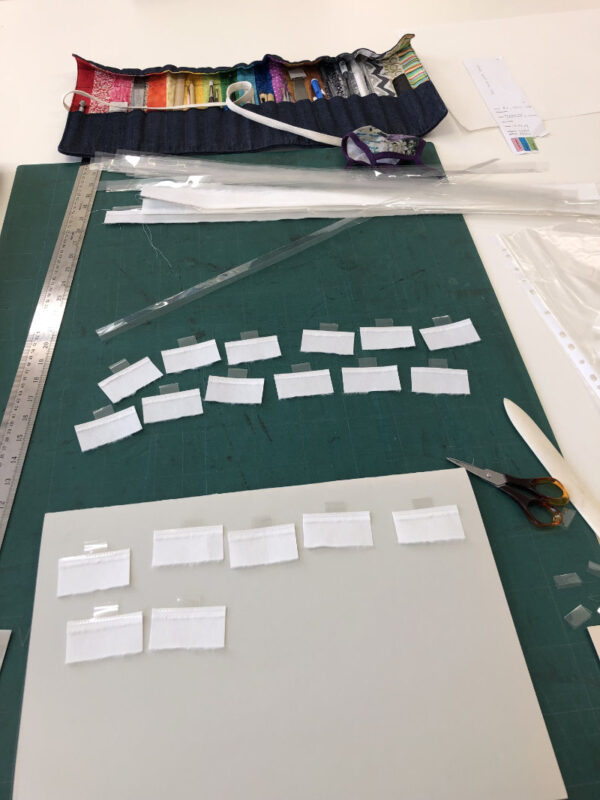

Preparation of the hinges following the method of QAGOMA. Images: Artlab Australia.
Artlab has recently started a multidisciplinary study of an unpublished pioneering map of the city of Adelaide, in collaboration with the University of South Australia, the Migration Museum (History Trust) and the State Library of South Australia.

From left to right, Daniel Williams (UniSA), Roberto Padoan (Artlab), Michael Bowditch (UniSA) and Corinne Ball (Migration Museum – History Trust) working on the high resolution 3D scanning of the map. Image: Artlab Australia.
In January 2020, a framed map of Adelaide dated December 1838 belonging to the Migration
Museum (History Trust of South Australia) came to the Paper & Books Lab of Artlab Australia for condition assessment and rehousing. The map was originally thought to be a print.
During the preliminary assessment, it became clear that the map is completely hand drawn. A more detailed study—carried out with high-resolution imaging at various illumination angles and microscopy imaging—revealed evidence that the surface of the map retains a vast number of intrinsic elements such as: perforation holes and embossed lines caused by compasses and other drawing instruments, pencil marks and a vast number of annotations.
This finding places this document under a new light, identifying it as an unpublished early drawing of Adelaide and its suburbs (Adelaide was founded in 1836) produced in the office of Colonel William Light and Boyle Travers Finniss. The map retains the original backing cloth mounted on a frame and it appears it has not received extensive conservation treatment. For this reason, the level of potential information of the intrinsic elements embedded in its composing materials is still very high.
The preliminary data and the research targets were presented by Roberto Padoan and Michael Bowditch at the AICCM webinar ‘A recently re-examined map of Adelaide from 1838 by Light Finniss & co.: 3D scanning and a multi-analytical investigation’.
You can watch a recording of the webinar here
The re-discovery of this map and the identification of its documental and historical importance for the early colonisation of Adelaide has attracted the attention of media that has reported the starting of this project on Channel 7 News:
A client contacted Artlab recently after finding a 1934 bottle on a beach near Ceduna, South Australia, with an envelope stuck inside. The client’s request to access the fragile paper item initiated a visit to the South Australian Maritime Museum to confirm the vessel from which it may have been thrown, followed by the team from Artlab calling on the experts at the Jam Factory (Art-glass blowing lab) to open the base of the bottle.

Senior Paper Conservator Aquila Evill and Principal Conservator Roberto Padoan assessing the condition of the message after the cutting of the bottle at the Jam Factory. Image: Artlab Australia.
Back at the laboratory, Artlab’s Senior Paper Conservator Aquila Evill with the assistance of Principal Conservator Roberto Padoan extracted the envelope and carefully removed the delicate letter inside, revealing a hand-written message dated 28 October 1938.
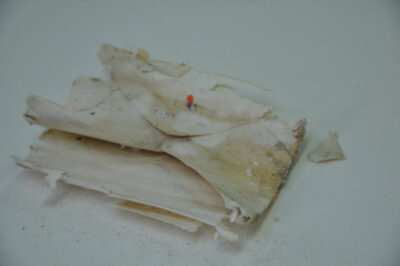

The envelope containing the letter extracted from the bottle and the letter after the extremely delicate opening. Images: Artlab Australia.
The sensational event of the opening was picked up by the TV program Sunrise
Objects
The Objects Lab said au revoir to Zora Sanders and Carolyn McLennan who were a terrific help in getting us through our workload, and a pleasure to have in the lab.
A team of conservators has worked tremendously hard to achieve excellent outcomes, rehousing the Aboriginal artefact collection at the South Australian Museum Store. We said goodbye to Helen Behrens and Isabelle Waters with much gratitude for their contribution, while Kenny Monger and Fiona Hurel will see the project to the end.
Megan Sypek recently worked on a collection of eight silver fruit knives. The blades of the knives had partially separated from their handles and the client was keen to reverse this and continue to use them. Examination and collaboration with an expert silversmith led to several revelations: the knives were made from Alpaca silver, and the knife blades were thermally set into the handles with resin. Alpaca silver, also known as German silver was developed in 1823 as part of a competition to develop an alloy similar to silver. Alpaca is a copper alloy containing nickel and zinc. The ‘ALP’ stamp on the knives supports this.
Dark red resinous material was visible where the blade was located in the handle. It was found this material softened with the application of heat. To treat the knives, each handle was almost completely submerged in a beaker of boiled water and left for three minutes. The blades could then be easily pushed back into their correct position in their handles. Once cool the knife blades were secure. A surface polish was carried out with Hagerty’s silver foam to complete the treatment of the knives. The client promised to keep the knives out of the dishwasher henceforth. Acquiring satisfying nuggets of information, such as how Alpaca silver was developed, really add to the education (and geek credentials) of the conservator.
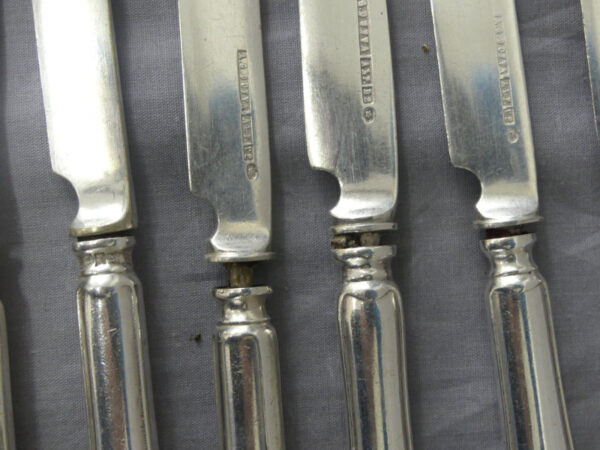
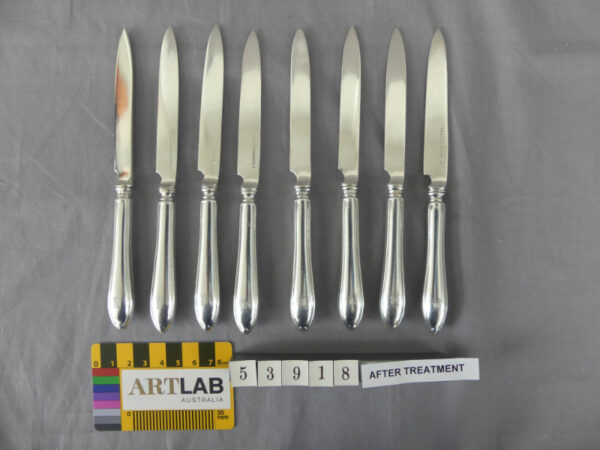
Detail of the knives before treatment, with the separated handles and scratched silver visible and the set after conservation. Images: Artlab Australia.
Sophie Parker and Andrew Cuch completed the packing of the beautiful Kulata Tjuta, an installation of 550 spears and 39 piti and made by many Community artists from the APY Lands. It represents the explosion at Maralinga, with the spears hung in a giant ball around a single light globe. It was an epic project intercepted by lockdowns and cancelled exhibitions, but finally went to Santa Fe. The objects will be permanently stored in their travel crates and were made as compact as possible.
Textiles
The Textiles team has been busy with exhibition preparation recently, including installing a range of textiles for A Vast Emporium at the Art Gallery of South Australia, (now on show); assisting with the mounting of costumes for The Centre of Democracy’s Stitch and Resist, hosted at The Mill; and preparing loan items for Embroidery: Oppression to Expression at The David Roche Foundation.

Mary-Anne works on a sampler book from the Migration Museum, History Trust of SA, in preparation for the exhibition Embroidery: Oppression to Expression at the David Roche Foundation. Image: Artlab Australia.
Tasmania
Libraries Tasmania and the Tasmanian Archives
Conservation, Government Archives and Preservation
Current projects
We’ve been busy with our usual work of preparing archival items for digitisation, assisting access staff with requests for fragile material and providing a steady stream of conservation advice for staff.
Our volunteers have continued describing and rehousing the Mercury negative collection, including copying the original boxes and envelopes to retain for future reference. Stephanie McDonald and Gaynor Tollard have finished a phase 1 project to move the boxes of negatives from horizontal stacking to vertical stacking to prevent too much weight on the lower glass plates.
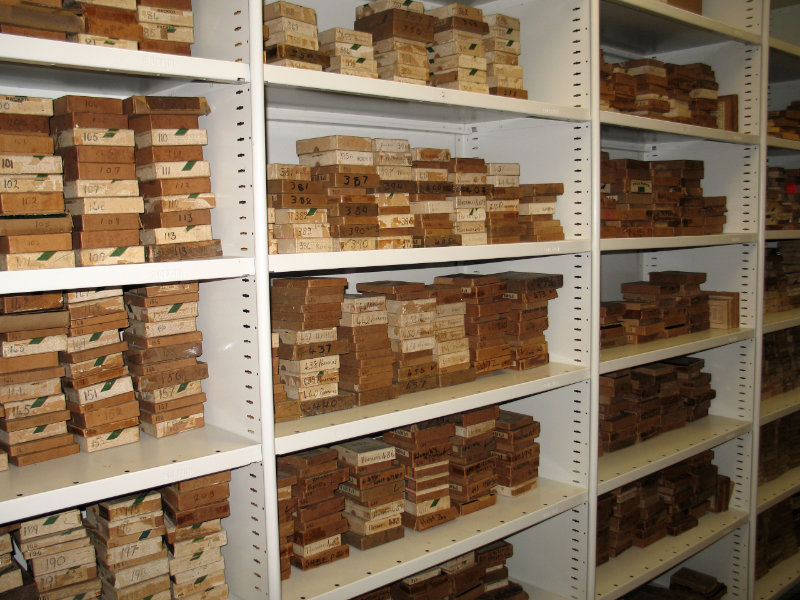
Mercury negatives before re-packing.

Mercury negatives after stored vertically within boxes with temporary labels.
Stephanie also prepared four items from the Allport Library and Museum of Fine Arts to go to the Tasmanian Museum and Art Gallery for the Wainewright exhibition.
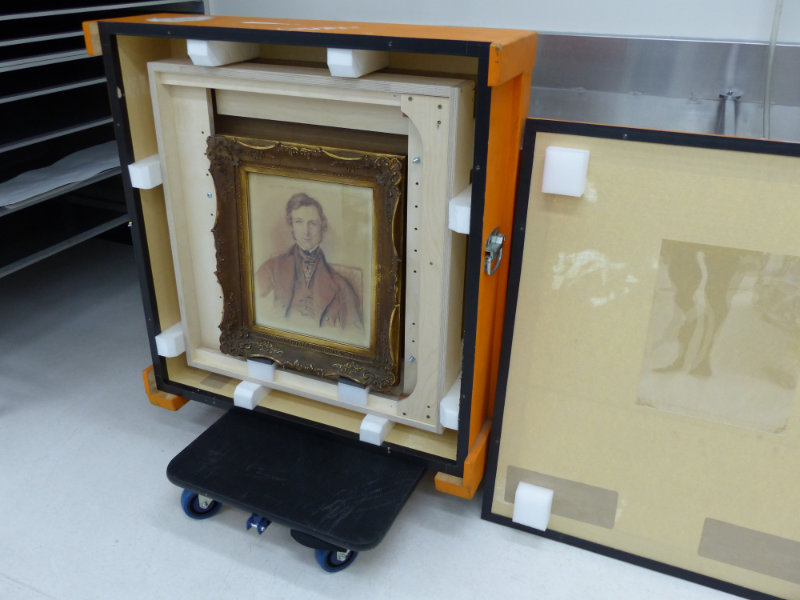
Thomas Giblin by Thomas Griffiths Wainewright, prepared for loan.
Exhibitions
Exhibitions have dominated the work of the lab with the deinstallation of Banks’ Florilegium – Society Islands 1769 and the installation of 91 Stories. This exhibition is based on our location (91 Murray Street) and showcases public submissions of stories about items from our collections. We prepared about 53 of the 91 selections for the exhibition and they ranged through 19th-century artworks, maps, photographs, posters and gaol records. Unusual objects were the miniature scrimshaw domino set and the Chopper Read board game.
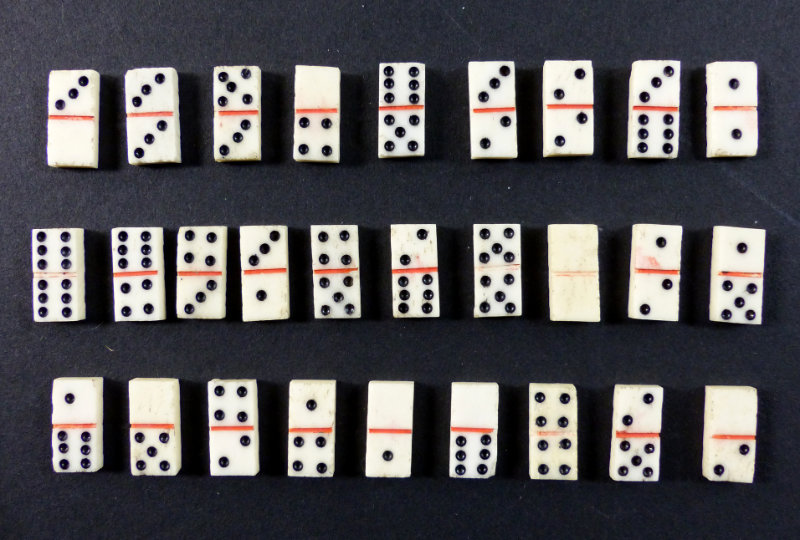
Miniature whalebone domino set (Crowther Collection).
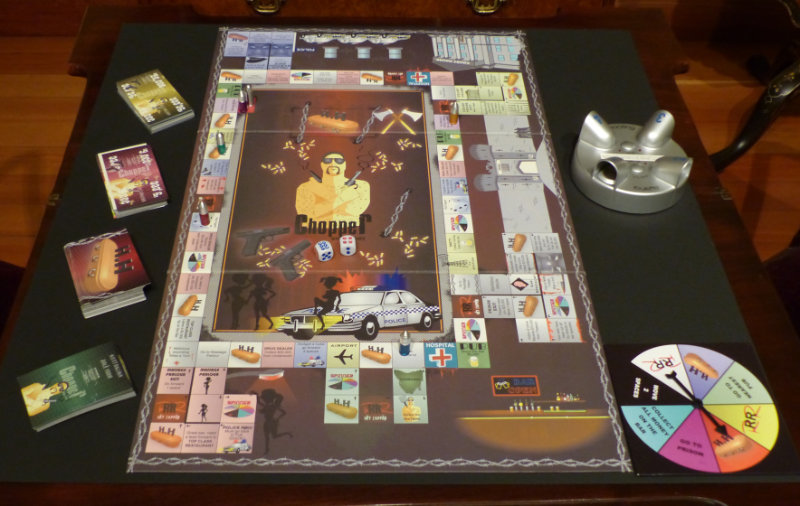
Chopper Read board game.
Victoria
Australian Centre for the Moving Image (ACMI)
ACMI’s Registration and Exhibition Production teams have just completed the first round of preventive conservation display changeovers in our permanent exhibition – the Story of the Moving Image (SOMI). Registrar Meg Taylor has been working closely with Textile Conservator Marion Parker to bring our The Last Emperor costumes to life in the space. Marion treated the costume pictured prior to installation and identified some beautiful decorative Renaissance fabric on handmade linen, including patterns exquisitely stitched over paper with Latin text.
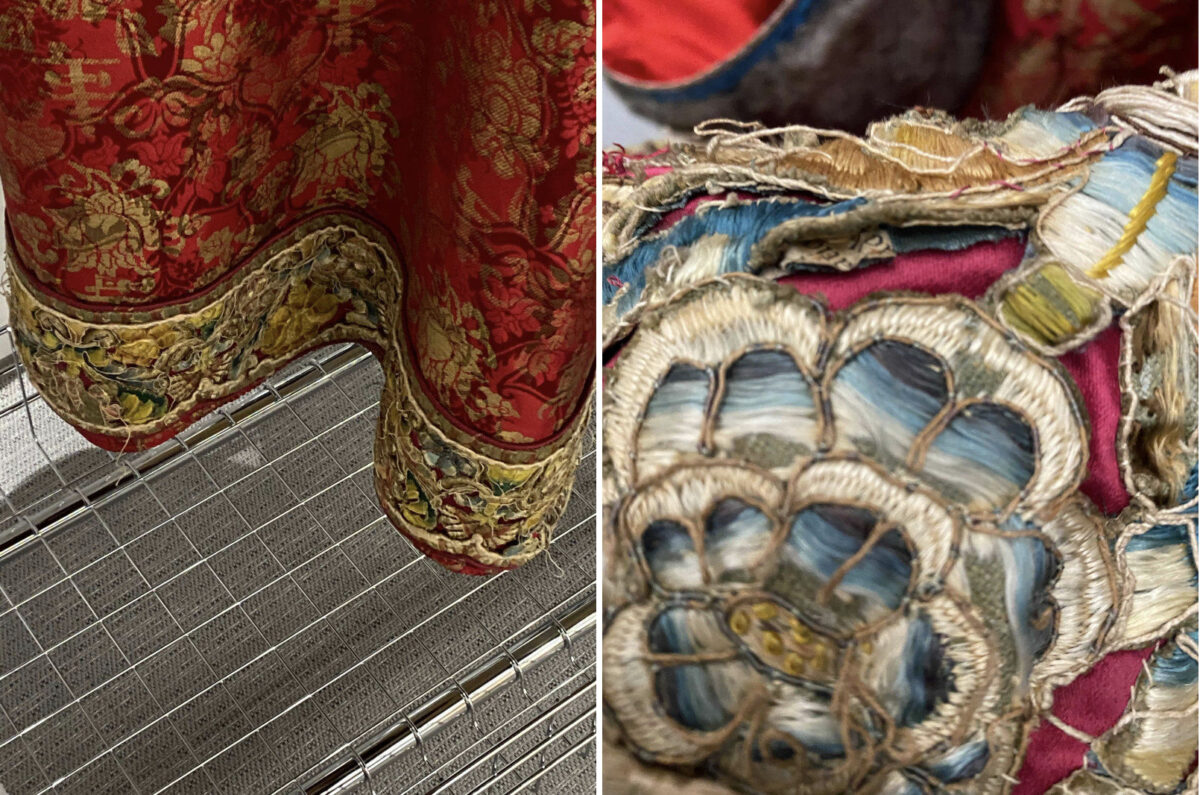
The Last Emperor, Mongolian Princess costume trim. Image credit: Meg Taylor. The Last Emperor, Mongolian Princess costume trim (detail). Image credit: Meg Taylor.
While digitisation of the ACMI Collection has temporarily ceased due to Melbourne’s current lockdown, preservation technician Ben Abbott has been delivering new content to the ACMI Collection YouTube Channel. A variety of films made by the Department of Agriculture (1940–60) make up an interesting new playlist with something for everyone. One stand-out gem is ‘Goodness – it’s Milk!’, an informative film looking at Victoria’s dairy industry in the 1960s set amongst the backdrop of the beautiful Blue Dandenongs.
Curator Chelsey O’Brien and Time-based Media Conservator Candice Cranmer presented a talk as part of ICOM’s Collecting with Care: Ethics in Museum Work webinar in July, exploring responsive display and agile preservation mechanisms in the ‘Moving Minds’ section of SOMI. Specifically, they spoke to the importance of exhibiting and archiving contemporary, current local and world events in the Museum and Collection through the ‘Catch of the Day’ display.
Grimwade Centre’s Master of Cultural Materials Conservation student Samantha Rogers recently interviewed Jesse Dyer—the inaugural ACMI/Grimwade Time-based Media Fellow—about his research with the ACMI Collection team and Grimwade Centre for Cultural Materials Conservation. Looking at preservation strategies for our extended reality artworks (utilising Unity in their production), Jesse will be furthering his research in interviewing a range of practitioners and experts in the coming months and has also been invited to SensiLab to speak about his project. Jesse and Candice also attended an Extended Realities Forum hosted by Deakin University, Deakin Motion Lab, ACMI X and Frame Documentary where Candice presented on ‘Archiving and preservation of extended reality media’, looking at the preservation of VR in ACMI’s Collection.
Grimwade Centre for Cultural Materials Conservation
Update on the Masters Program
We started the year with a committed and clever cohort of students, which is a good sign for the profession – as they say, a ‘glass half full’ and resilience are the most important skills in these present times. As such, teaching in the Masters program has included a mix of online, on campus and practical sessions in the lab, and making the most of our time at the Grimwade Centre when we are free to move about. There are some students offshore and interstate, however, so they are enjoying our recorded video demonstrations and live practical video streaming together with materials being sent to people’s doorsteps. It is a new way of thinking about conservation teaching, and like many conservators we’ve learnt so many more ways to do things remotely. This keeps us agile just in case another lockdown emerges.
Preventive Conservation with Nicole Tse finished just before another lockdown. We had a great line up of content with guest lectures from Mary-Jo Lelyveld (NGV), Elizabeth McCartney and David Coxsedge (MV), Lyndon Ormond-Parker (ANU), and our Grimwade Centre honorary Sabine Cotte. Likewise Digital Protocols with Robert Lazarus was online with guests Patricia Falcao from the Tate and Mick Newnham; while Conservation Professional Practice with Robyn Sloggett, Respect and Introduction to Treatment with Jonathan Kemp included many guest lecturers—Gabriel Nodea from Warmun, Angeletta Leggio from University of Melbourne Archives, Marcelle Scott, Mahmoud Mohammed from the Islamic Museum and PhD student Bronwyn Cosgrove, to name but a few.
Mid-year there was some heavy lifting at the Grimwade Centre with the Stone Intensive with Jonathan Kemp and PhD student Hohi Ikeda (see images). This saw some 30 students immersed in hands-on work involving stone cleaning, consolidation, lime pointing, grouting and colour-matched repairs. There was also a special lecture on monument surveys and linked-data by Dr Stefania Chlouveraki of the University of West Attica in Athens. This was enabled through the Erasmus partnership between Grimwade and West Attica, and afterwards students selected monuments in Melbourne’s General Cemetery for their condition surveys and treatment proposals. From the information gathered we hope to start building a data-driven understanding of the cemetery’s patterns of stone decay in relation to climate and geology.



Stone Intensive activities. Image credit: Dr Jonathan Kemp.
We are also proud of our Indonesian alumnus Saiful Bakhri, who was awarded a Rising Star Alumni Award to present the Bali Art & Heritage Conservation Internship Program #BAHCIP together with alumni Gadis Fitriana Putri, Lia Sumichan and Laila Nurul Fitrani. The program included an immersive, in-country conservation program for Indonesian students, and an online lecture series for both Indonesian and Grimwade Centre students for peer-to-peer links to develop with heritage professionals in Indonesia. The lecture series also included Grace Barrand, Selina Halim, Nicole Tse and others.
As such our Masters students love to be engaged and our commercial team – Grimwade Conservation Services – is providing many volunteer opportunities. We would also like to thank our national and state collecting institutions, private and public galleries and heritage places that are supporting our students through formal internships or mentoring. Everyone needs a little guidance and, with more online activity, one-to-one professional encounters are very important. Students, we encourage you to join the AICCM ASAP and join any AICCM State Division event as these are great professional opportunities and a chance to be part of our AICCM resilient community.
Wider engagement: Grimwade Centre staff Nicole Tse, Holly Jones-Amin, Libby Melzer, Vanessa Kowalski and Marica Mucic are lecturing into the Masters of Curatorship program, Issues in Conservation. Nicole also enjoyed catching up with Associate Professor Zhanyun Zhu from Xiamen University and presented a guest public lecture on Paintings Conservation in Southeast Asia: Materiality, Values and Conservation Knowledge. Jonathan Kemp gave a lecture and seminar on archaeology and stone conservation to both staff and students of the Graduate Program in Museology and Heritage (PPG-PMUS) at the Universidade Federal do Estado do Rio de Janeiro (UNIRIO), and staff from the Museum of Astronomy and Related Sciences (MAST).
Grimwade Visiting Research Fellows and Scholars
The Grimwade Centre Visiting Scholar 2020–21
Kencho Dekar is a master traditional dye-maker from Bhutan and the only person in Bhutan engaged full time in the traditional process of natural dyeing, as an art and as an ecologically sound and sustainable activity. His father, who was a civil servant of the Ministry of Trade, started the National Handloom Development Project (NHDP), Khaling in Trashigang. With few practitioners, and higher costs than chemical dyeing, this tradition is endangered. Kencho Dekar has conducted research into traditional dyes and has produced new dyes using traditional plants over the past 20 years. Today he has a viable business producing dyes for traditional weavers in Bhutan, thereby supporting the traditional Bhutanese textile industry. Kencho teaches traditional dye making; business development; quality control and assessment; and the economic development potential of traditional knowledge as a sustainable future. Kencho has a deep passion and unwavering commitment to preserve and advance the art of natural dyeing and is keen to contribute to further study and disseminate this art within a Western academic environment
The Grimwade Centre Visiting Scholar 2021–22
Dr Barkeshli is a world expert in traditional inks and pigments in Middle Eastern manuscripts. She has worked over the past decade on texts in the Middle Eastern Manuscript Collection at the University of Melbourne. Dr Barkeshli is a conservation scientist specialising in the materials technology of Islamic manuscripts and miniature paintings. Her work examines materials used in Persian and Moghul manuscripts and miniature paintings from paper leaf, dyes and sizing materials, to binding mediums and pigments based on traditional knowledge. Her work links textual research on historical treatises and scientific analysis of pigments, dyes, inks and papers. She is internationally recognized for patent findings on traditional preservation measures in Iran such as saffron stigmas as an inhibitor for green verdigris pigment corrosion in Persian miniature painting, and henna dye used as a fungicide in the Persian paper dyeing process during the 16th to 19th century.
The Miegunyah Indigenous Fellowship
Gabriel Nodea has held leadership positions as Chairman and Cultural Facilitator at Warmun Art Centre, and as a director and past deputy director of Arnhem Northern and Kimberley Artists (ANKA). He also held the position of Acting Chairperson, Kimberley Law and Culture Centre (KALAC), and as a court translator and interpreter when required. Gabriel is well known as a dancer and singer of several significant joonbas and other performances. He initiated and built the Joonba (Corroboree) Ground next to the Warmun Art Centre, which is now an important place for cultural events. Gabriel holds post-graduate qualifications in the Specialist Certificate in Cross Cultural Conservation and Heritage. He is co-coordinator for the second year Masters subject Ngarranggarni: Gija Art and Country.
Indigenous Scholar-in-Residence
Lynley Nargoodah is a Nyikina/Walmajarri woman from Fitzroy Crossing. As Special Project Manager at Mangkaja Arts Resource Agency and current Chairwoman of Mangkaja Lynley is at the forefront of a new movement in remote Indigenous storytelling and art centre management. Lynley is dedicated to sharing Mangkaja’s historic collection with the world and works with art centres and national institutions to share the importance of Indigenous knowledge that only exists in the custodianship of Indigenous peoples. She is a curator, collections manager and conservator. Lynley is a University of Melbourne alumnus, graduating in 2019 from the Specialist Certificate in Cross Cultural Conservation and Heritage.
Executive-in-Residence
The Grimwade Centre’s Executive-in-Residence Program brings experts in conservation in Australia and overseas to spend time at the Centre, mentoring the Centre’s staff and students and working with them on projects that focus on knowledge transfer through teaching and research. John Hook is the 2021 Executive in Residence. John has been a pioneer in Paintings Conservation for over 40 years. He has held significant positions at the National Gallery of Victoria and the Queensland Art Gallery, including Head of Conservation, and in this role has supported Grimwade interns and research projects since the Centre started in 2004. John has also contributed to the teaching programs, sharing his extensive experience on an annual basis. In 2021 he is sharing his collection of painting samples for staff and student research. This collection represents a unique resource in Australian paintings conservation.
Grimwade Conservation Services
Sustainability in Conservation
Recently, GCS joined the Green Impact Program in an effort to reduce our carbon footprint in the workplace. We are proud to announce that we were awarded the 2021 Green Impact Cup – Australasia – for our uptake of the program and our implementation of many sustainability actions. We thank student volunteer Ru Hui Foong for assisting us in joining this initiative and helping us to modify our workplace practices, both in the lab and office.
Conservators out and about
With lockdowns and travel restrictions in place across much of Australia, GCS staff have been busy assisting in the installation of upcoming exhibitions at various locations across the state on behalf of interstate conservators not able to travel to Victoria currently.
Conservation training videos
The University of Melbourne awarded internal grant funding to GCS to develop and test a pilot project, which delivers an education offering that enables rural, regional and remote communities to protect and conserve their local cultural material.
This pilot project will include six online training modules that seek to standardise basic teaching content, which in the past has been delivered bespoke to clients based on individual needs. Two program partners have co-contributed funds and resources to support the project and will validate the modules via post-development testing. The program partners represent two local market segments in need of conservation training but challenged by the barriers of remoteness, education and financial resources—Moa Arts (Ngalmun Lagau Minaral Torres Strait Islander Indigenous arts community) and Bathurst Regional Council (arts centre and historical society workers and volunteers).
Filming of the modules has commenced, with roll out to the partners to happen in the next couple of months. This project seeks to deliver basic conservation training to art and heritage collection custodians.
Research: ‘Exploring best-practice conservation workflow management systems for large organisations.’
Ainslee Meredith, Evan Tindal and Penny Tripp have been working on the research project ‘Exploring best-practice conservation workflow management systems for large organisations’. In many collecting organisations, aspects of conservation workflow (such as the identification and prioritisation of conservation needs; quoting and approval conservation jobs; tracking work; and managing digitisation requests) are carried out manually. This has ramifications for aligning conservation needs and budgets, as well as for tracking and prioritising conservation activities.\
To assess the potential for conservation workflow to be integrated into digital collection management systems, interviews are being conducted at a range of collecting organisations based in Australia and internationally. The interviews will generate data that will be used to propose a best-practice solution for the industry.
If you would like to contribute to the research, please contact Ainslee
National Gallery of Victoria (NGV)
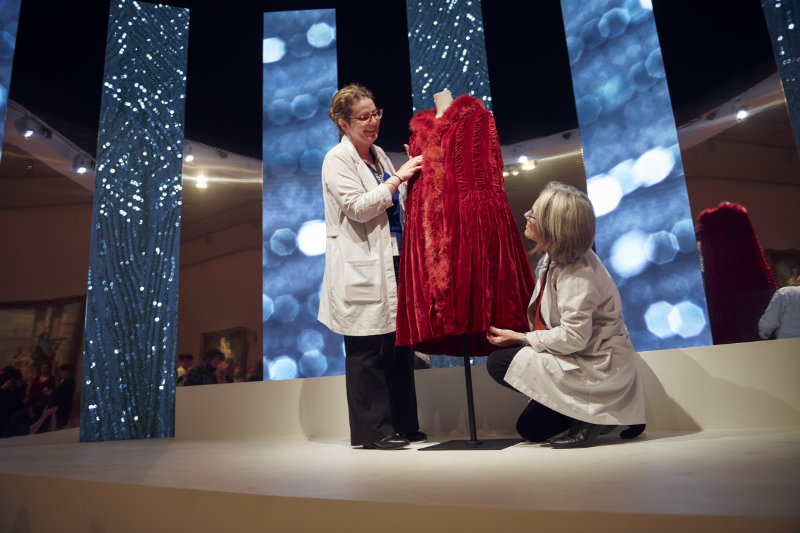
Senior Textiles Conservator Skye Firth and Textiles Conservator Di Knight prepping a new acquisition for the Chanel exhibition media announcement. Image courtesy of the National Gallery of Victoria Conservation Department.
Hello from Lockdown 6. After completing a milestone of 200 days in lockdown here in Melbourne, we are very well rehearsed in pivoting/shifting priorities/moods with a nice sprinkling of comfort eating and tangential wonderings.
Though our doors continue to swing open and shut, the varied activities of the NGV Conservation team continue to persevere.
In partnership with the Public Galleries Association of Victoria (PGAV), the NGV Conservation department has delivered a series of monthly webinars for PGAV members and their network of museum professionals dedicated to collection care. Over the last few months, the team has delivered ‘Material Specialty’ sessions focused on the handling, display, storage and maintenance of works on paper and unframed, large-format paintings and Indigenous barks. The ‘Advancements in Collection Care’ sessions have included setting environmental guidelines for collections and virtual condition reporting. Attendees have included collection managers, registrars, technicians and directors from over 30 art galleries and art museums. The sessions have been well received with 90 per cent of respondents rating their experience as excellent, with many applying their learnings from the webinar to their work practice. These webinars will continue through 2021.
This year we had to make a last-minute change to our plan for Science Week, but we were still able to deliver an engaging online campaign. This included a video post, and a series of stories including a quiz, a call out for questions (we received over 150!) and some answers including video responses. All up it reached over 70,000 people! You can view the archived story here under the ‘Science Week’ tile
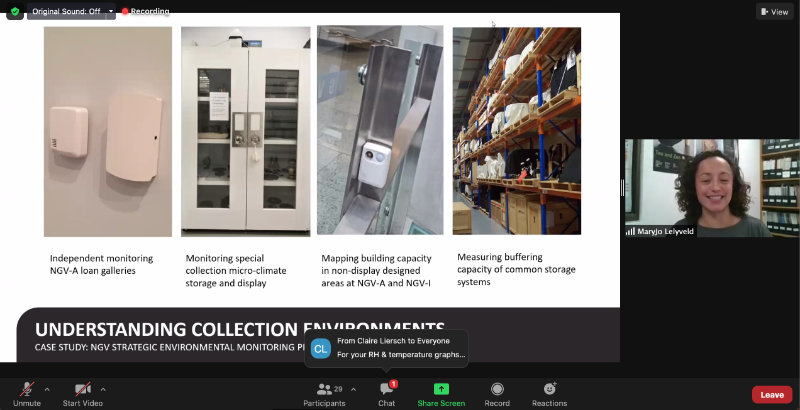
Coordinating Conservator MaryJo Lelyveld presenting on Collection Environments in a PGAV online webinar. Image courtesy of the National Gallery of Victoria Conservation Department.
In the lead up to the current exhibition Goya drawings from the Prado Museum, paper conservators Louise Wilson and Ruth Shervington have examined in greater detail the printmaking and papers used by the artist in the four famous series held in the NGV collection. This examination and related research has been presented to various audiences online, as well as via an e-book produced in collaboration with Multimedia and Conservation Project Officer Jessica Lehmann on the NGV website
Photograph Conservator Pip Morrison has been assessing and carrying out minor conservation treatments on a number of early 20th-century photographs by female artists such as Lee Miller and Dora Maar, which have been recently acquired. Pip has also been looking into the stability of some UV-curing digital prints with University of Melbourne Masters student Rubie Bridie.
During this period we have also been lucky enough to host two conservation students from Melbourne University, Rubie Bridie and Sunita Lewis, for their work placements.
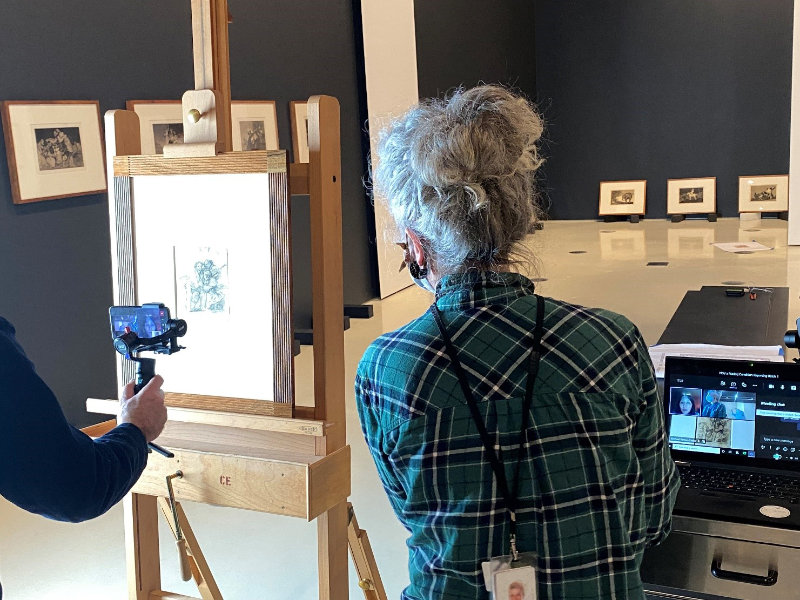
Senior Paper Conservator Ruth Shervington undertaking remote condition reporting of works for the Goya exhibition. Image courtesy of the National Gallery of Victoria Conservation Department.
The paintings conservation team has compensated for the limited opportunities to work at their easels by pursuing a number of important research and documentation projects while working from home. These projects have benefited enormously from two initiatives that were completed shortly before the pandemic hit in early 2020: the digitisation of the conservation records of paintings in the NGV, and a comprehensive condition survey of the thousands of paintings in the NGV storage facilities. These two projects took place over 18 months and filled significant gaps in our knowledge about both individual works and broader collection-wide issues. At the time we did not realise how timely and important these projects would come to be, but over the past year it has had a tremendous impact on our ability to carry out research and respond to enquiries and loan requests about paintings in our collection. Documentation projects like these can be tedious and call for a substantial investment of time, but the benefits continue to grow as we move forward to a more flexible work format, and we encourage other institutions to consider taking this step.
Lockdown has not prevented our heavy involvement with exhibitions, changeovers, loans and new acquisitions. Here are some other notable projects we have been involved with over the past few months:
Raye Collins and Raymonda Rajkowski have worked hard over the past few months to develop the program for November’s AICCM Painting SIG Virtual Symposium. In converting the symposium to a virtual format, they have had to quickly study the complexities of the largely untried medium as well as develop the thematic program. With the support of the NGV we hope and expect the symposium will be well received by conservators across the country. Raye and Raymonda have also been busy with numerous digital outreach projects organised by the NGV Conservation department, including the British and French Online Catalogues, the NGV Magazine, and social media. Raye has coordinated planning for the next stage of our longstanding collaborative relationship with CSIRO by continuing scientific research projects together, with a focus on varnishes used in conservation. In July, Raymonda gave a presentation on the handling and care of bark paintings in a webinar for the Public Galleries Association of Victoria.
Prior to lockdown, Caitlin Breare carried out structural repairs to a newly acquired full-length portrait by Marie-Victoire Lemoine (1754–1820) and was part-way through the varnish removal when on-site work was interrupted. She is also collaborating with NGV photographer Predrag Cancar on imaging techniques using Photoshop, and with Michael Varcoe-Cocks on the collaborative project between NGV Conservation and the Getty Conservation Institute, investigating the response of wood to changes in relative humidity via acoustic emissions.
Carl Villis is part-way through the retouching stage of his treatment of El Greco’s Portrait of a Cardinal and has been carrying out research with Caitlin on new x-ray systems for conservation purposes. This has involved an international survey looking into existing x-ray facilities in collecting institutions around the world and looks at alternative x-ray systems to better integrate radiography into the everyday work programs of conservators.
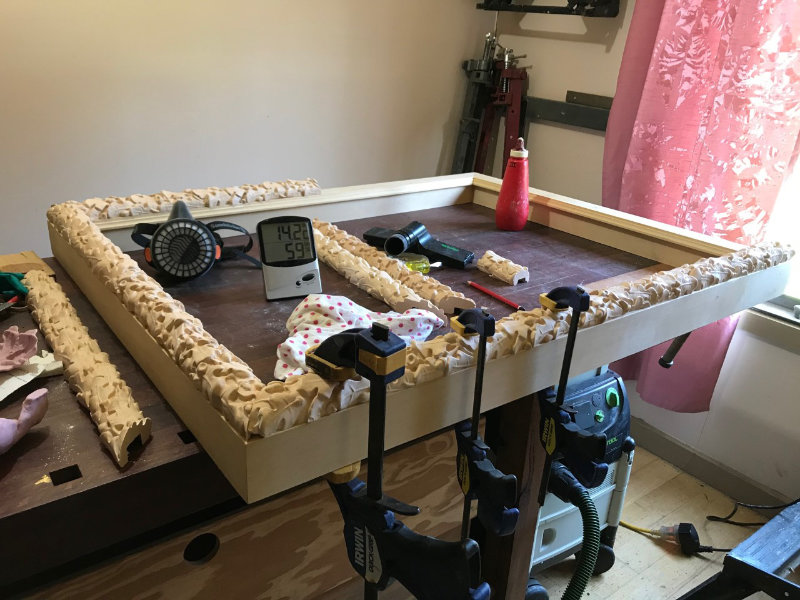
Frame maker Jason King working from home to complete the new frame for Portrait, (1893) by Frederick McCubbin. Image courtesy of the National Gallery of Victoria Conservation Department.
Between lockdowns, the furniture and frames team has been busy with treatments for permanent collection changeovers and frame-making projects.
Frames and Furniture Conservator Suzi Shaw has undertaken treatments on a range of new 20th-century furniture acquisitions to prepare them for display at NGV International. These include a 1934 Airline armchair by ‘Kem’ Weber, which was used for many years in the Disney Studios in Burbank, California. Many of the recently acquired works have heavily worn or degrading varnishes, such as cellulose nitrate, which are challenging in terms of stabilisation and inpainting losses. One of the two Butterfly stools by Isamu Noguchi required replacement of later show hardware with new versions of the original fittings, still fortunately made by the same company in Japan.
Preparation for display of the new acquisition Woman with a golden cloak, 1914, by Maximilian Lenz involved coordinated teamwork with Senior Frames and Furniture Conservator Holly McGowan-Jackson conserving the frame, Senior Paper Conservator Ruth Shervington undertaking treatment of the artwork, Conservation Framer Louise Bradley (private practice) creating a replica gilded mount and Senior Art Technician Gervais Battour fitting-up the work in the frame. The unusual artist’s frame required strengthening of the joints, repairs to large splits and losses in the timber and compo decoration, as well as surface cleaning of the faux wood-grain surfaces.
Frame maker Jason King has been immersed in two major frame-making projects, Portrait (1893) by Frederick McCubbin and The lady in white, 1878, by Annie L Swynnerton. Jason was able to complete attaching the plaster ornament and gilding the frame for the McCubbin while working from home, completing the frame in time for loan of the artwork. The frame for the full-length Swynnerton is a Watts style frame, with the profile composed of three parts, including an oak veneer frieze and four sections of running ornament.
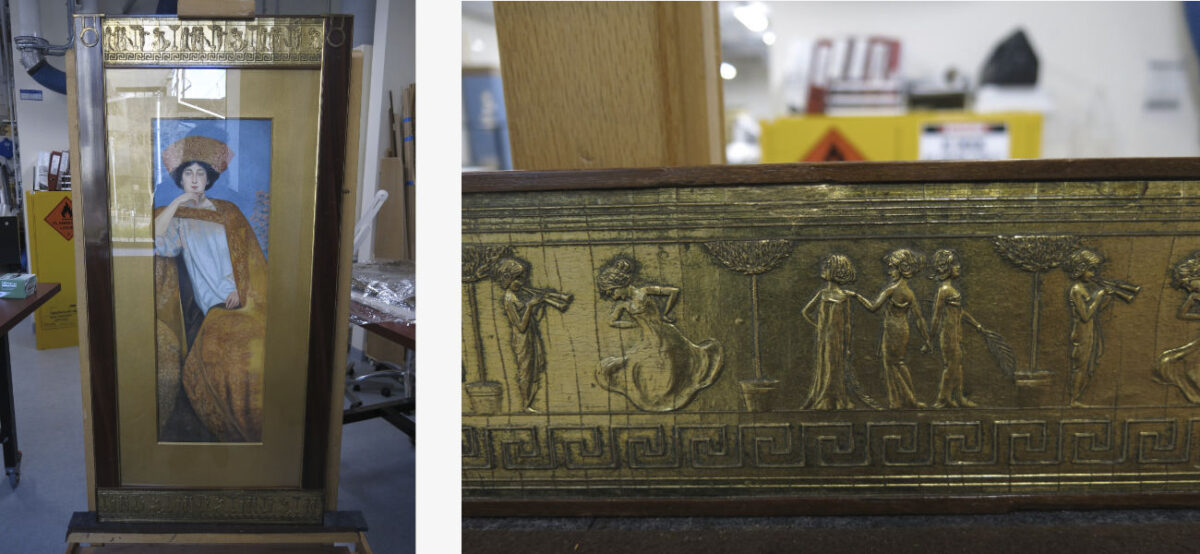
A quick snap of Woman with a golden cloak, 1914, by Maximilian Lenz, just before it went on display with its new frame; right: a repaired area at the bottom frieze of the frame. Image courtesy of the National Gallery of Victoria Conservation Department.
Life never gets boring for the objects team and mount makers. Despite on and off lockdowns we have kept busy with multiple activities from deinstallations of major Triennial works such as the magnificent chandelier To Die upon a kiss by Fred Wilson and Jeff Koons’ Venus, which is now on display in Federation Court, to preparations of objects for NGV collection displays and exhibitions. We enjoy the variety of materials and challenges presented by recent acquisitions, among those a large collection of Indonesian Wayang Kulit shadow puppets and Korean objects. A group of 12 Sèvres biscuit porcelain figures The scarf dance (Jeu de l’écharpe) and a Frank Lloyd Wright Window from the Avery Coonley House, Riverside, Illinois, also recent acquisitions, required more elaborate conservation treatments. For the display of the Frank Lloyd Wright window, a customised suspension system was built by our skilled mount-making team.
In May, the French Impressionist exhibition on loan from the Museum of Fine Arts, Boston, was installed with Senior Conservator of Exhibitions and Loans Catherine Earley’s assistance and couriers making the trip from Boston to the NGV via hotel quarantine in Sydney. By June, Catherine, Ruth and Michael were installing a Goya drawing exhibition from the Prado Museum with remote couriers from Madrid online from 7am to 3pm. Virtual reality has been embedded in our toolbox and Catherine recently shared research and practice via a PGAV presentation.
Despite the stop–start nature of the lockdowns and with increasing border closures making assessment and delivery of loans tricky, Conservator of Exhibitions and Loans Janelle Borig has been busy preparing and installing Maree Clarke: Ancestral Memories, including pest control of bundles of sticks ‘stored’ outside and the installation of a truly large possum-skin cloak fresh from the artist’s studio with help from Senior Textiles Conservator Skye Firth.
Janelle is currently deinstalling She-Oak and Sunlight: Australian Impressionism, including some remote condition reporting sessions with Catherine and Raymonda’s help, and Catherine is installing a Japanese lacquer exhibition supporting an amazing set of 720 gilded clam shells painted with 360 types of flowers and grasses forming a giant pick-up-two game. It’s a must see!
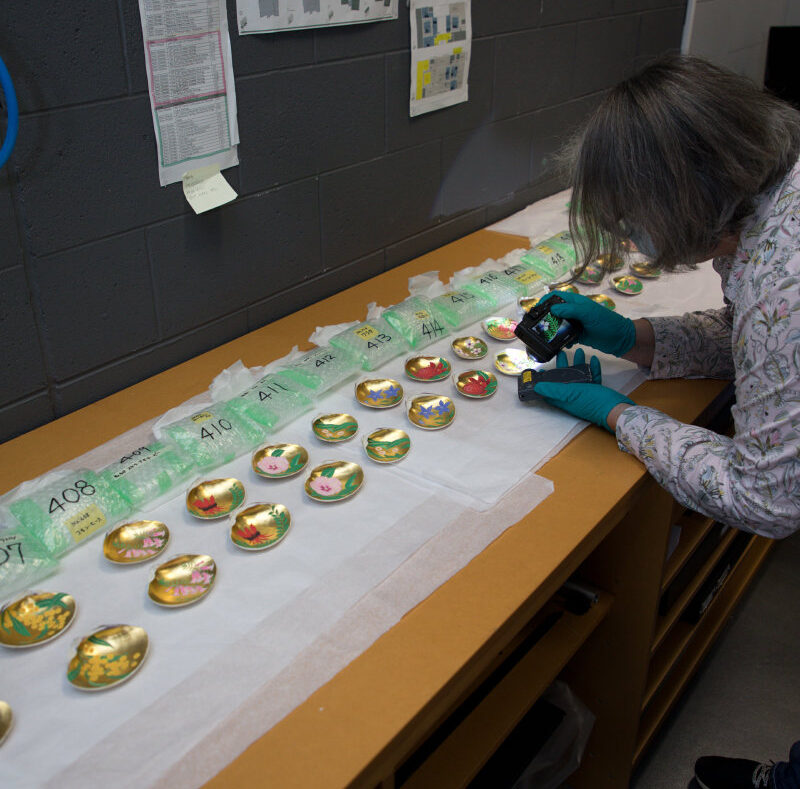
Senior Exhibitions and Loans Conservator Catherine Earley diligently working on the 720 gilded clam shells. Image courtesy of the National Gallery of Victoria Conservation Department.
Centre for Frame Research site launch
At the end of July, we celebrated (remotely) the launch of the Centre for Frame Research microsite on the NGV website, generously supported by the Professor AGL Shaw AO Bequest.
Centre for Frame Research | NGV.
Over many months, Conservation worked closely with members of the Multimedia and Photographic Services teams to create the site, based on the NGV’s ongoing work in the area over 30-plus years. We hope you enjoy it!